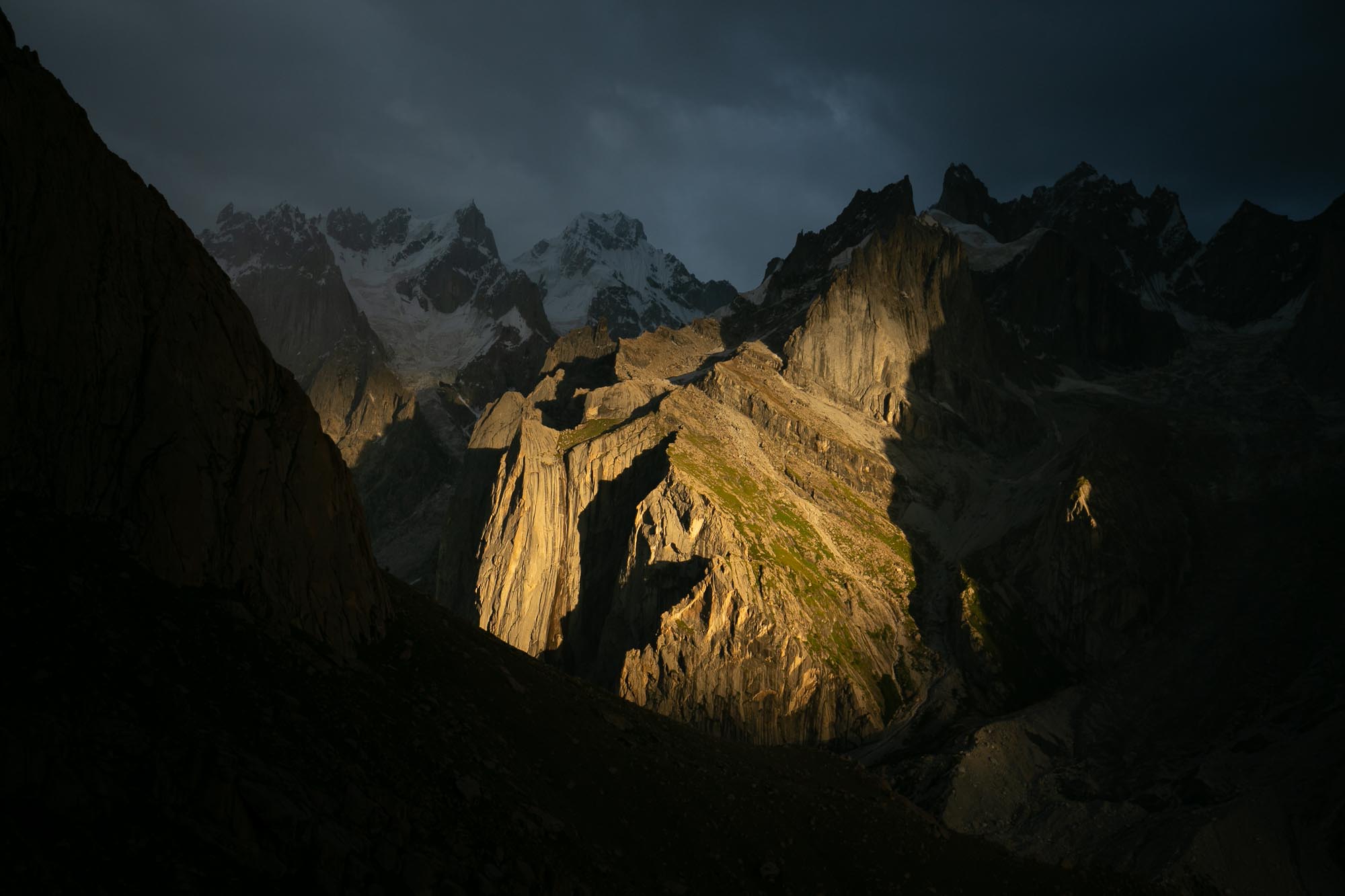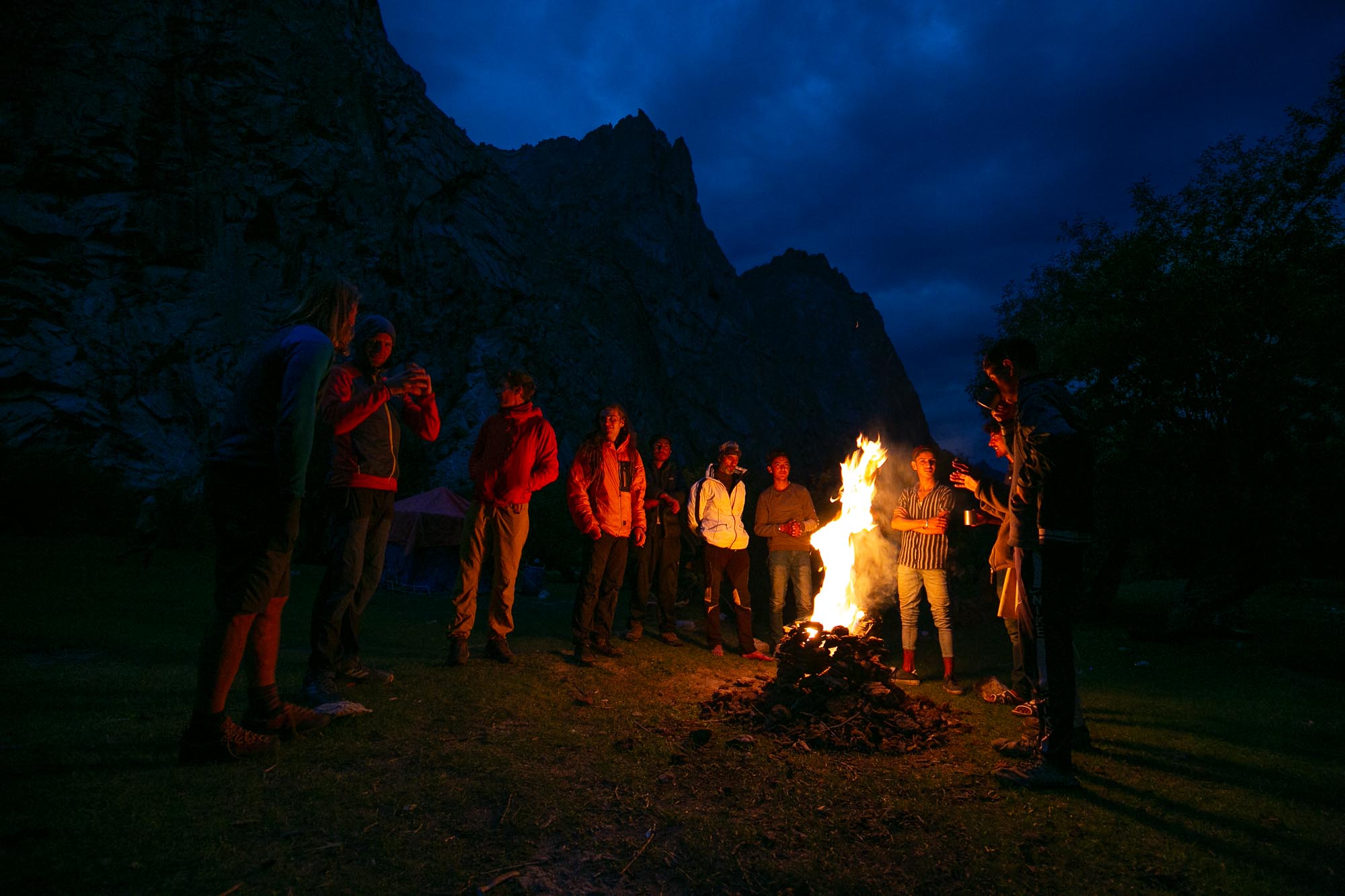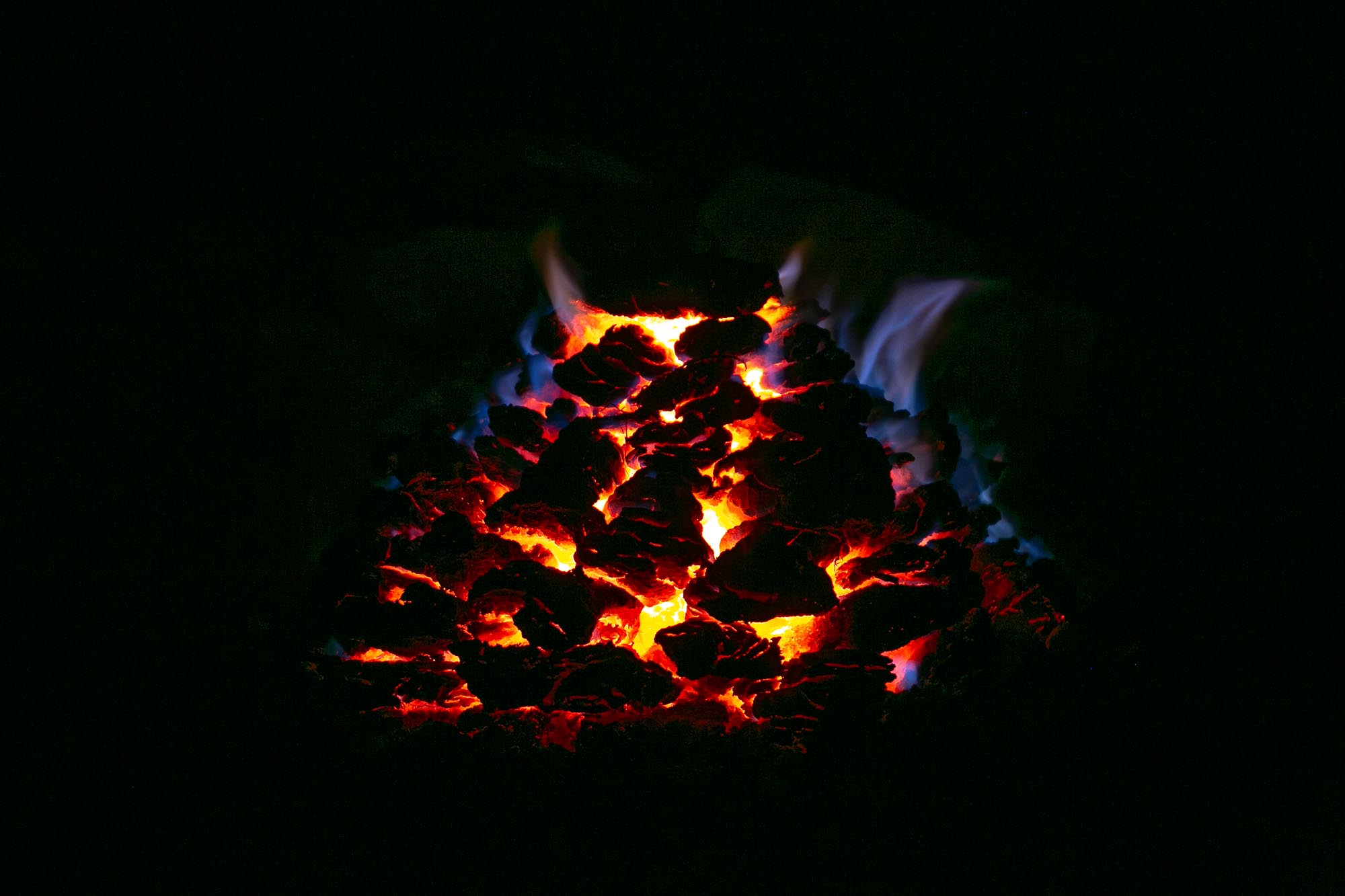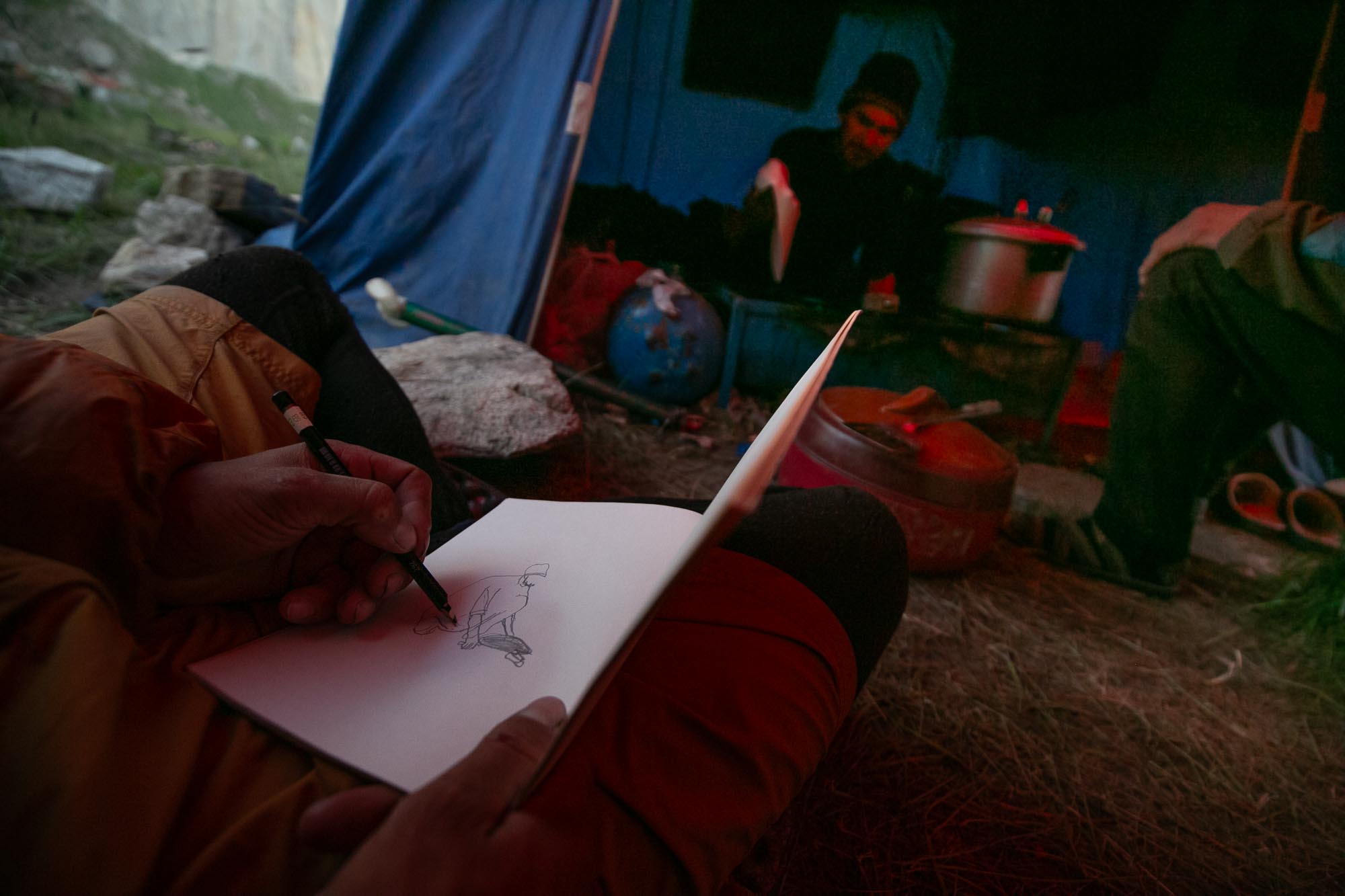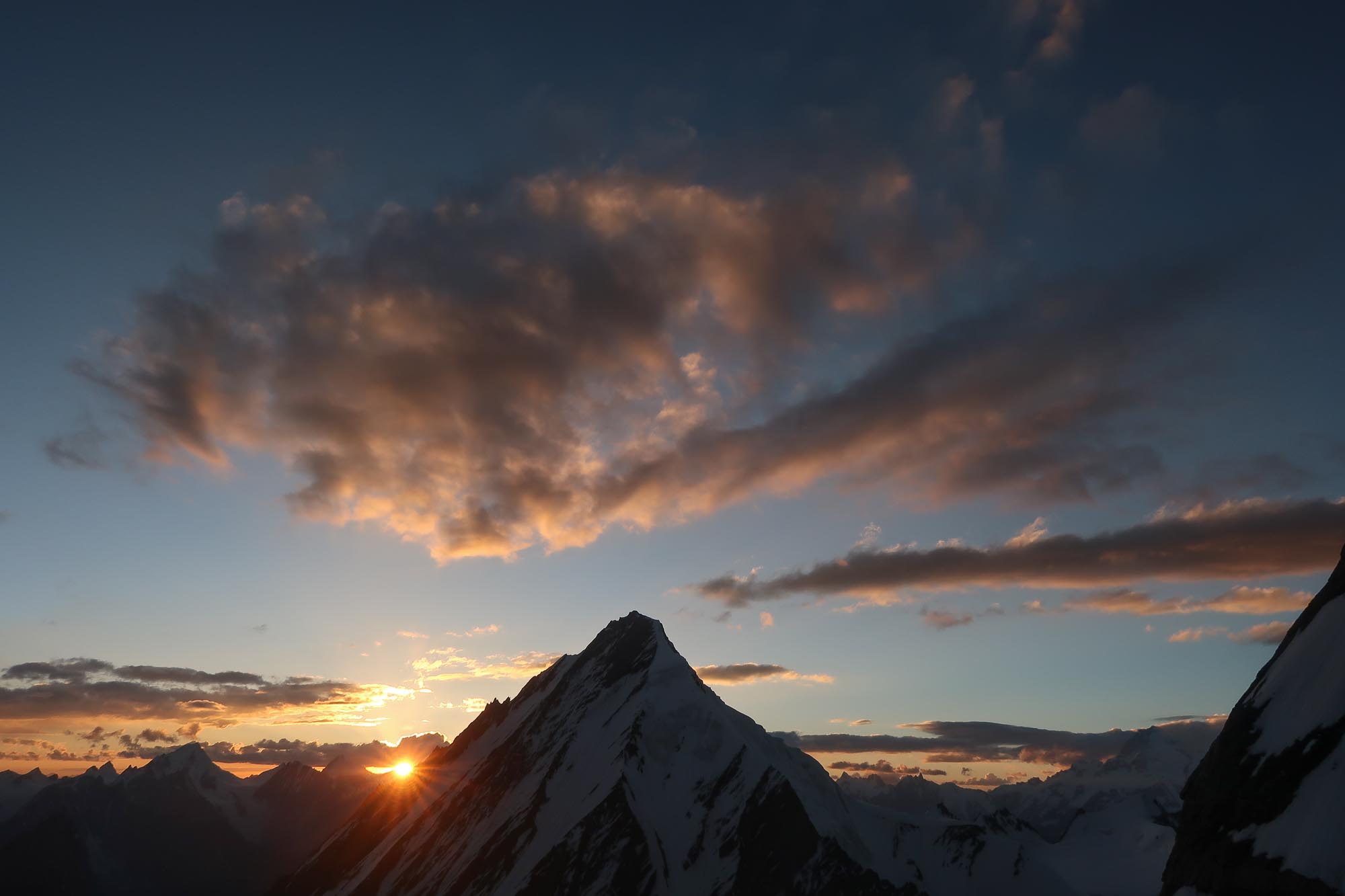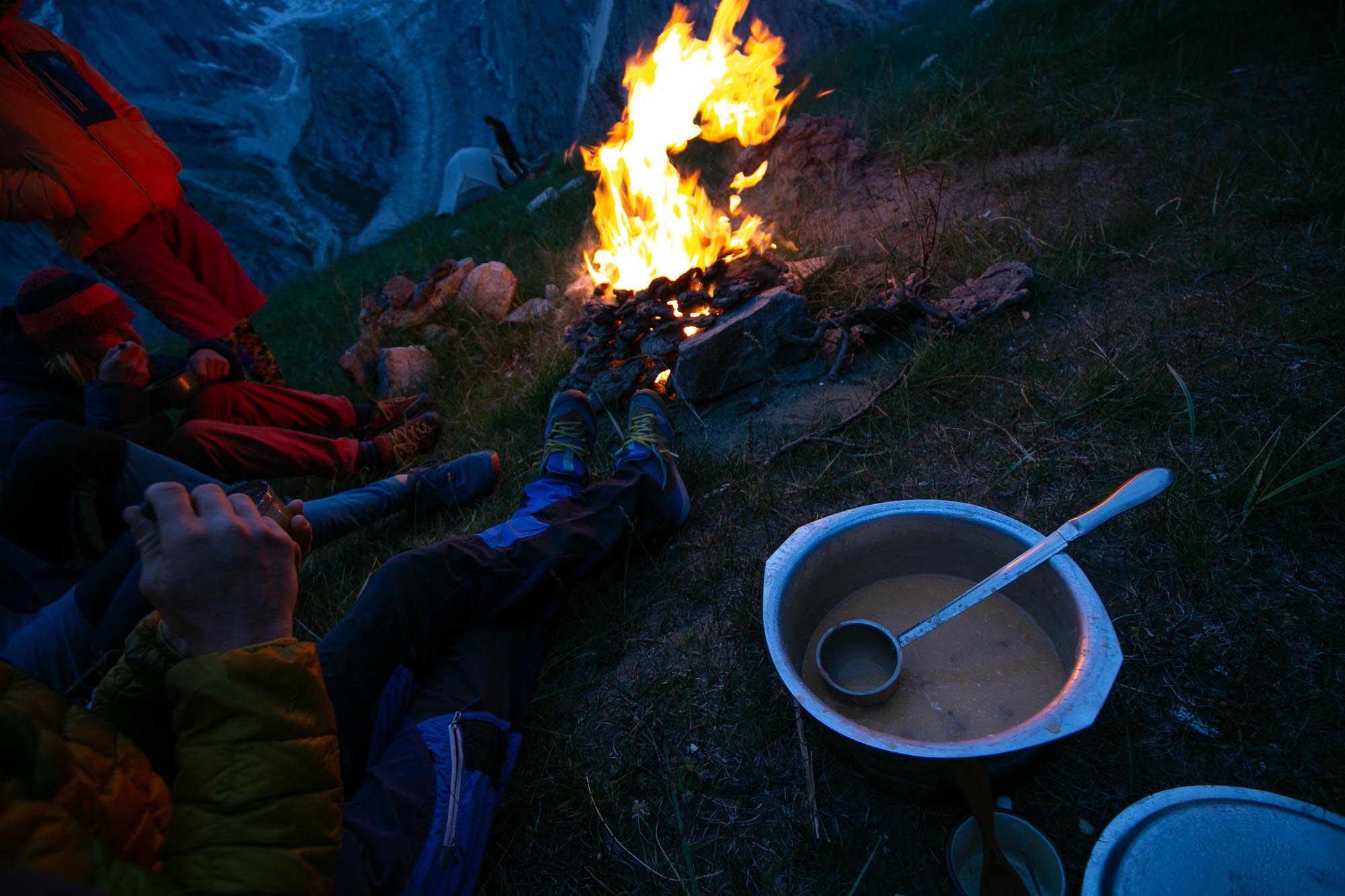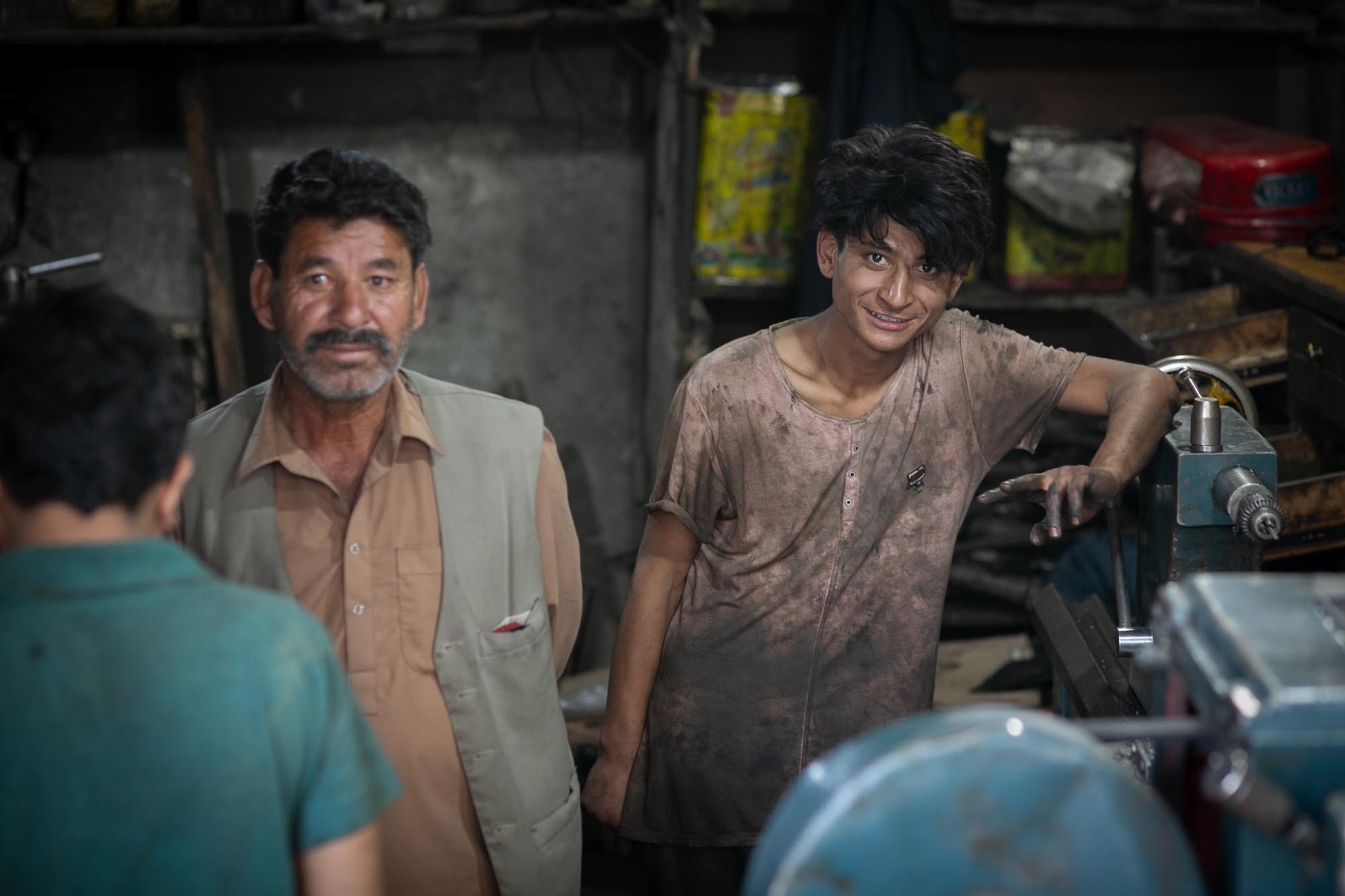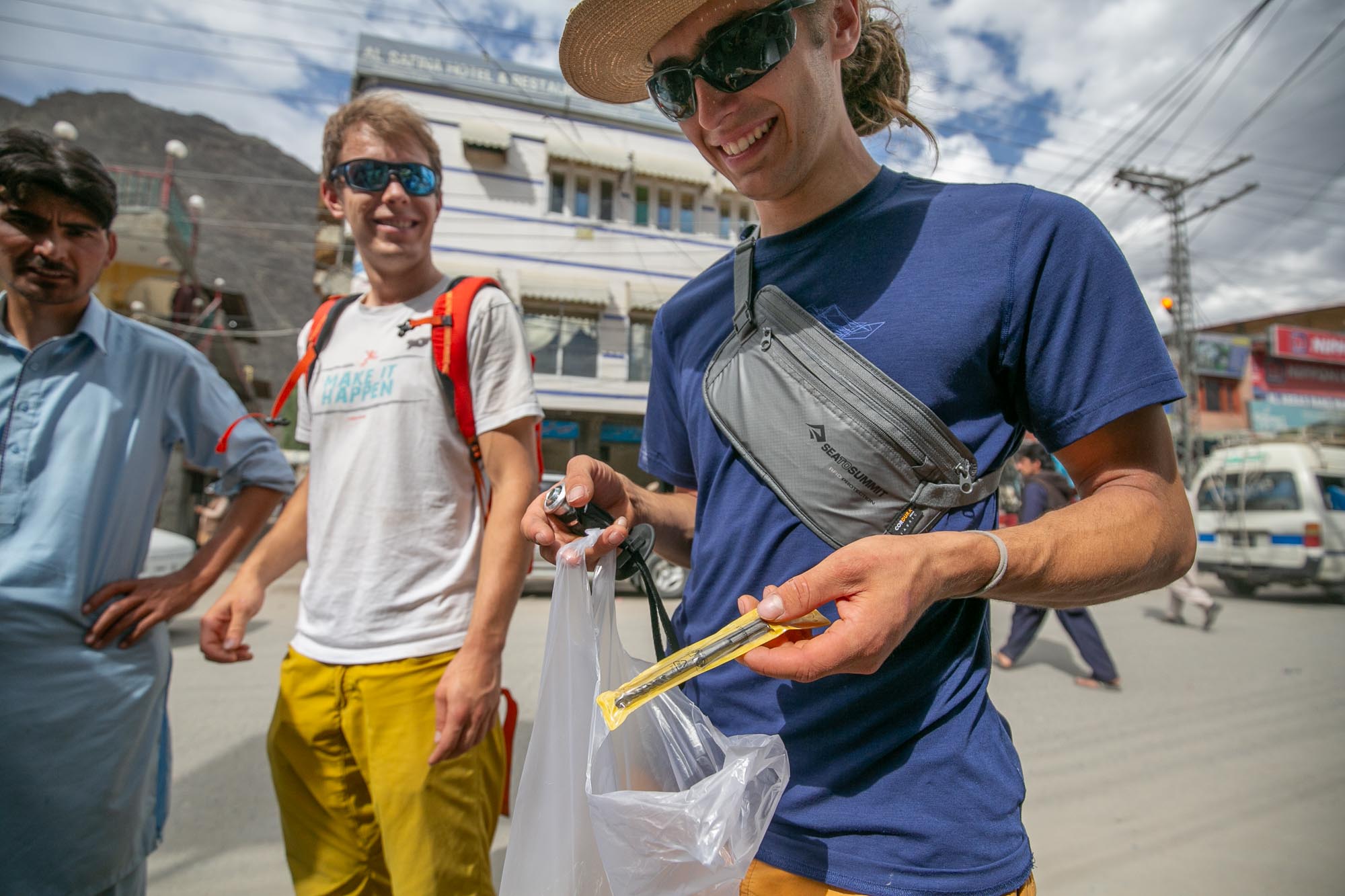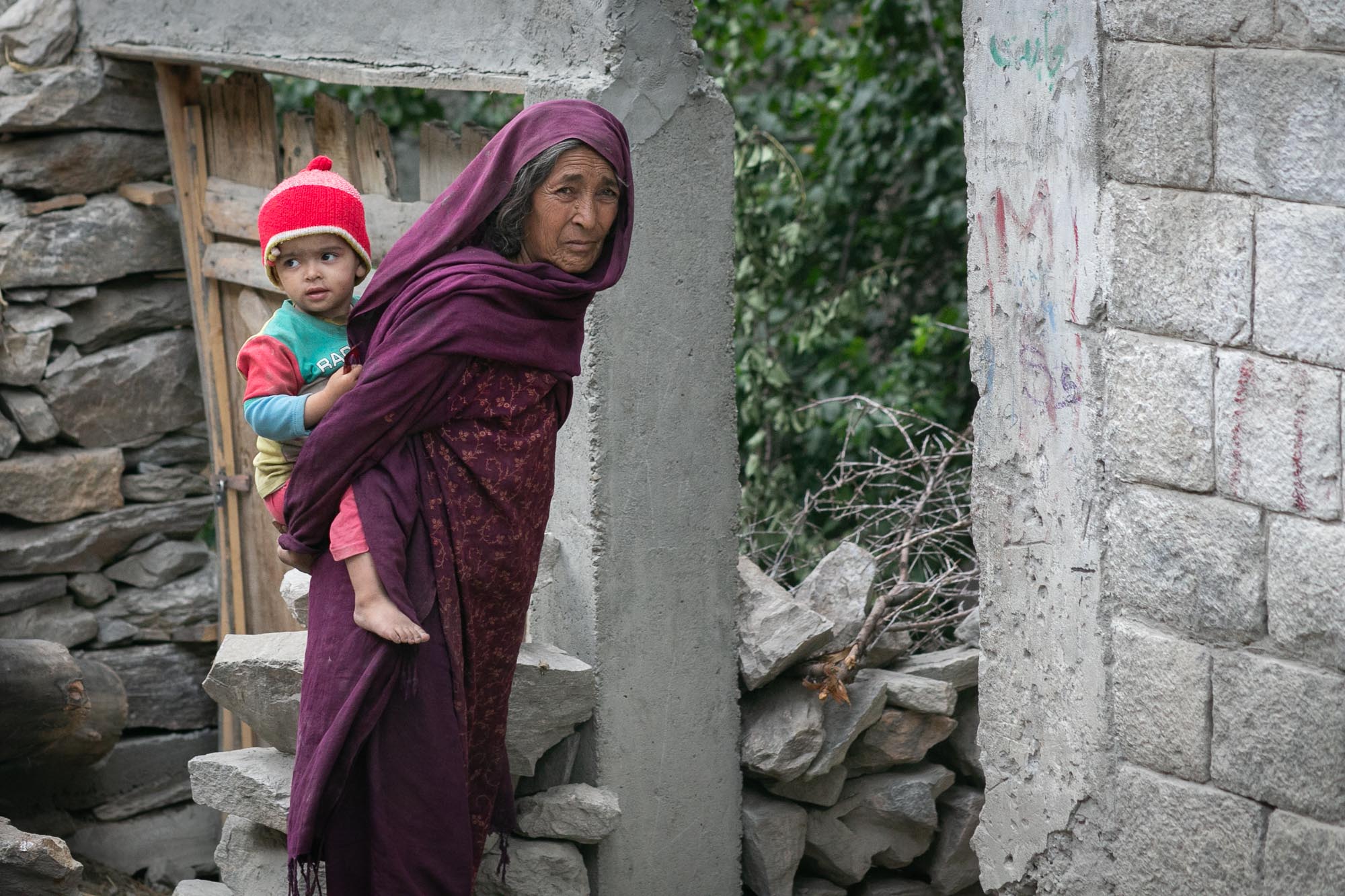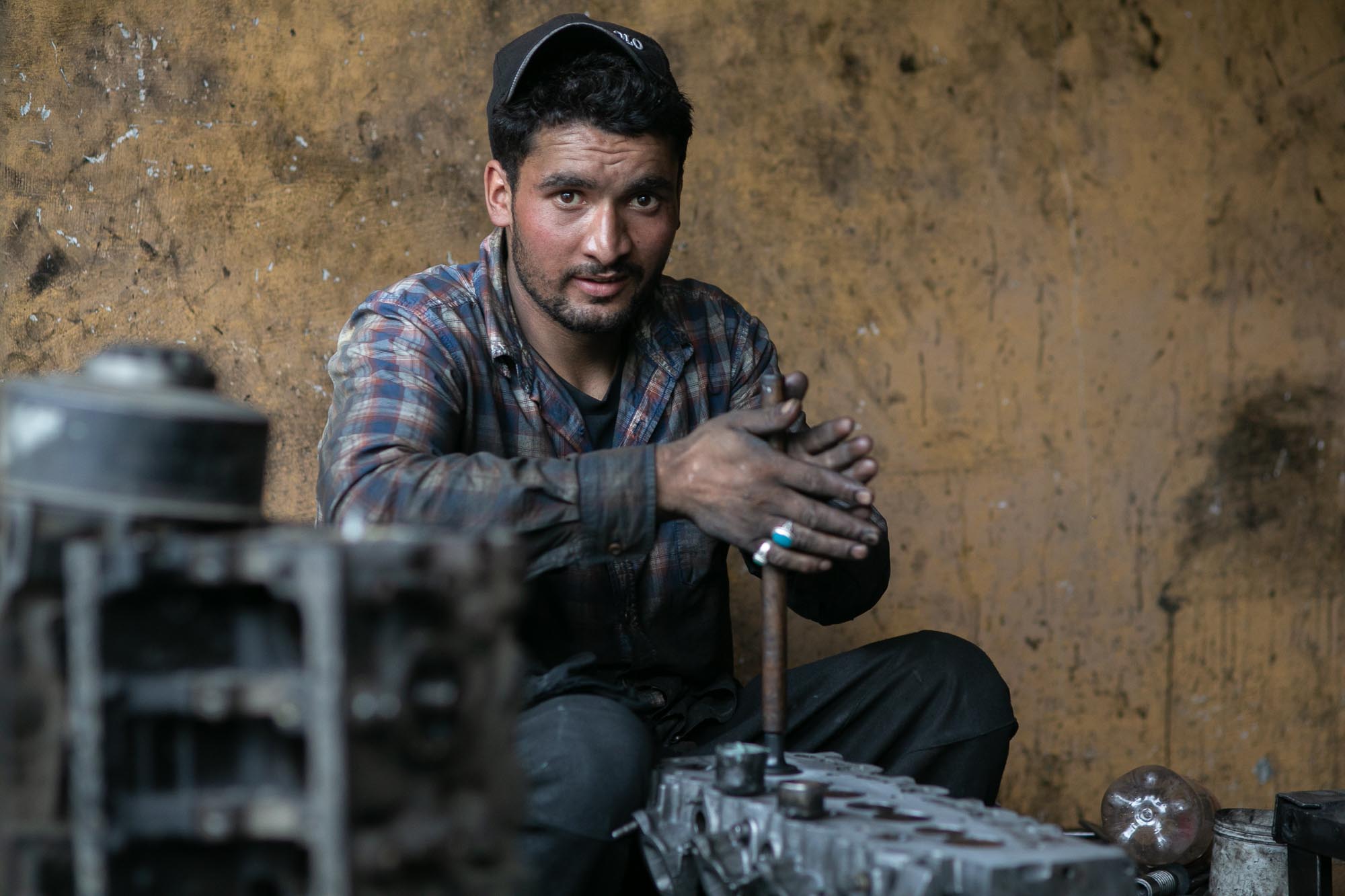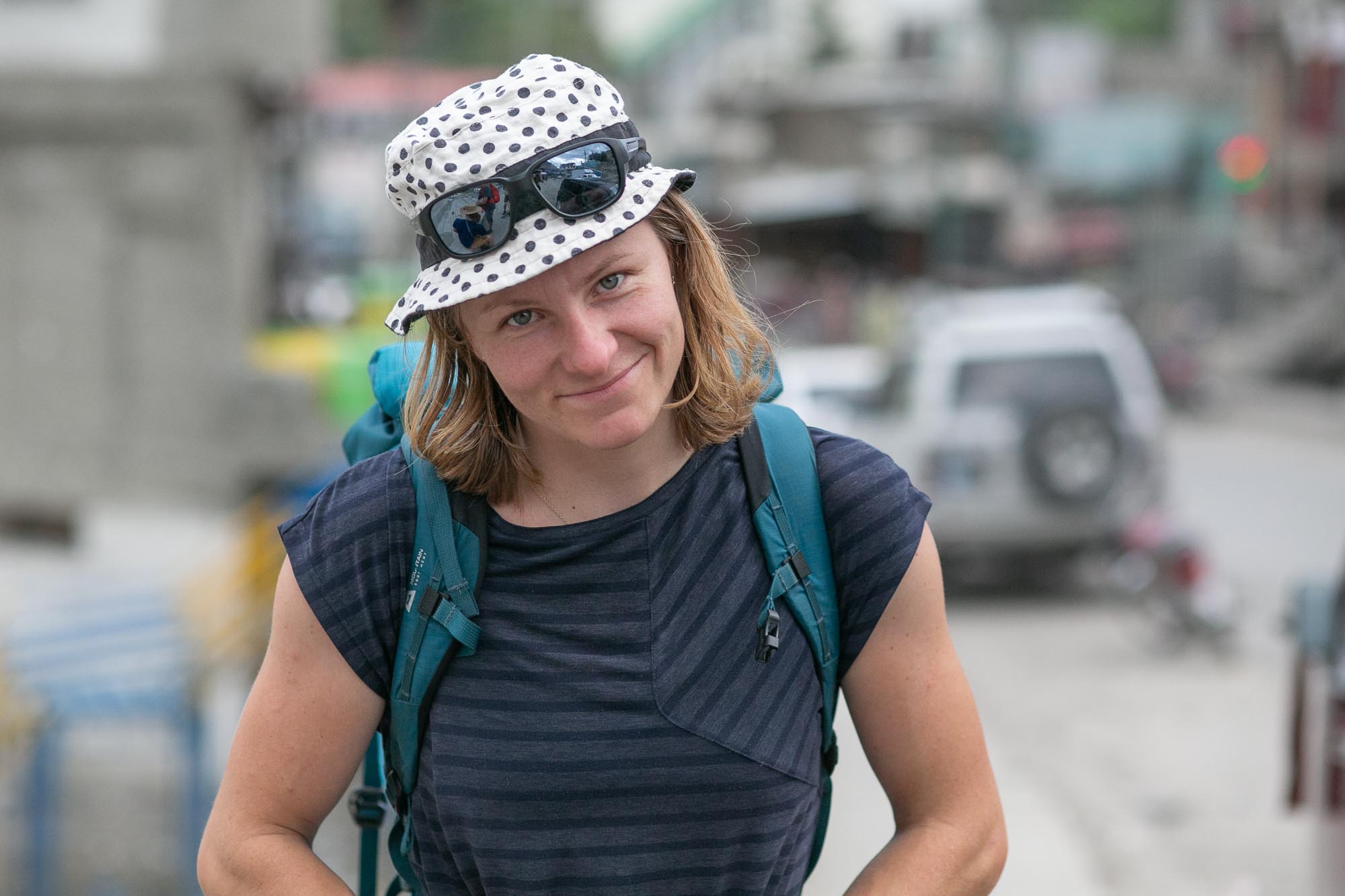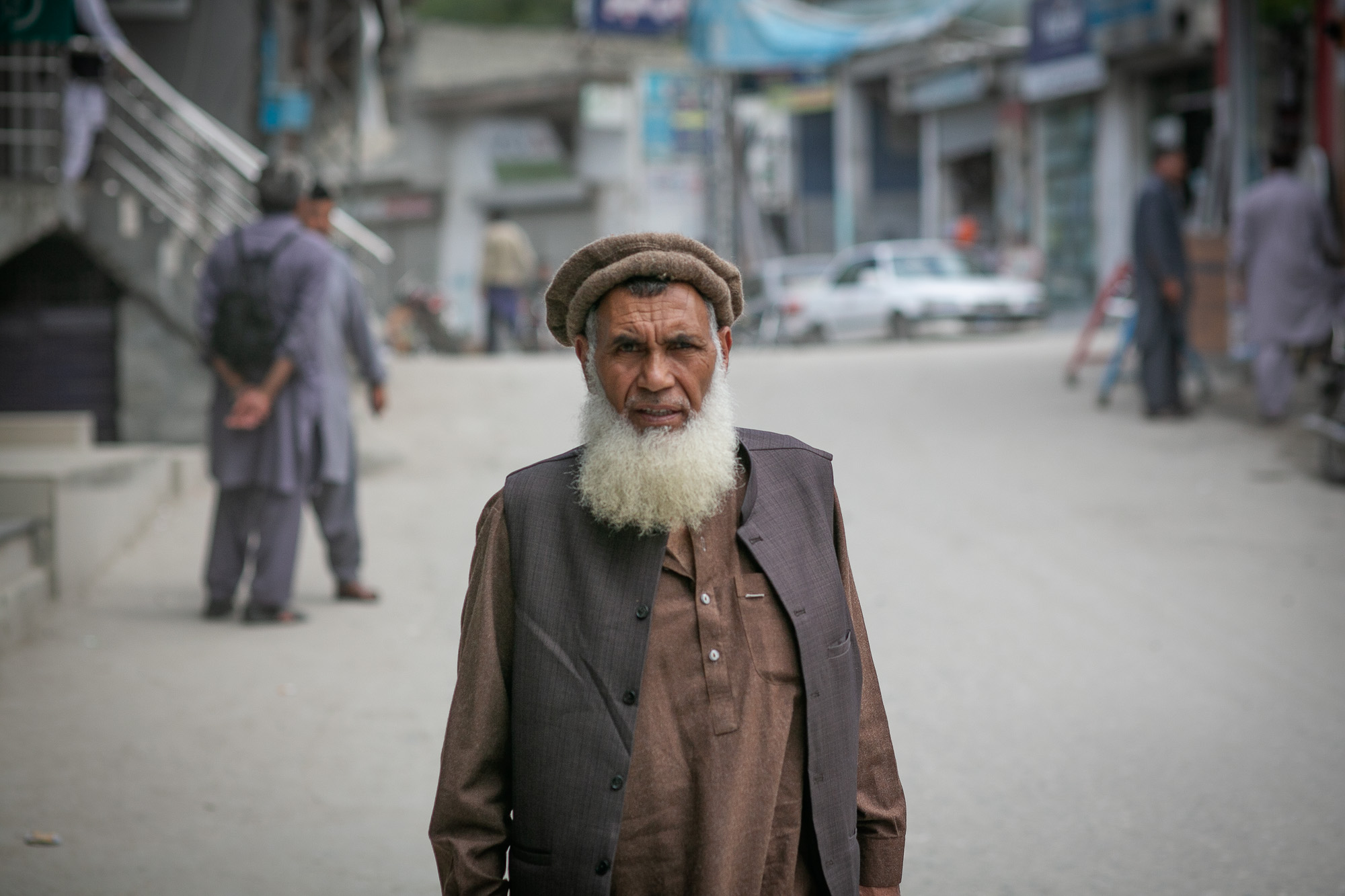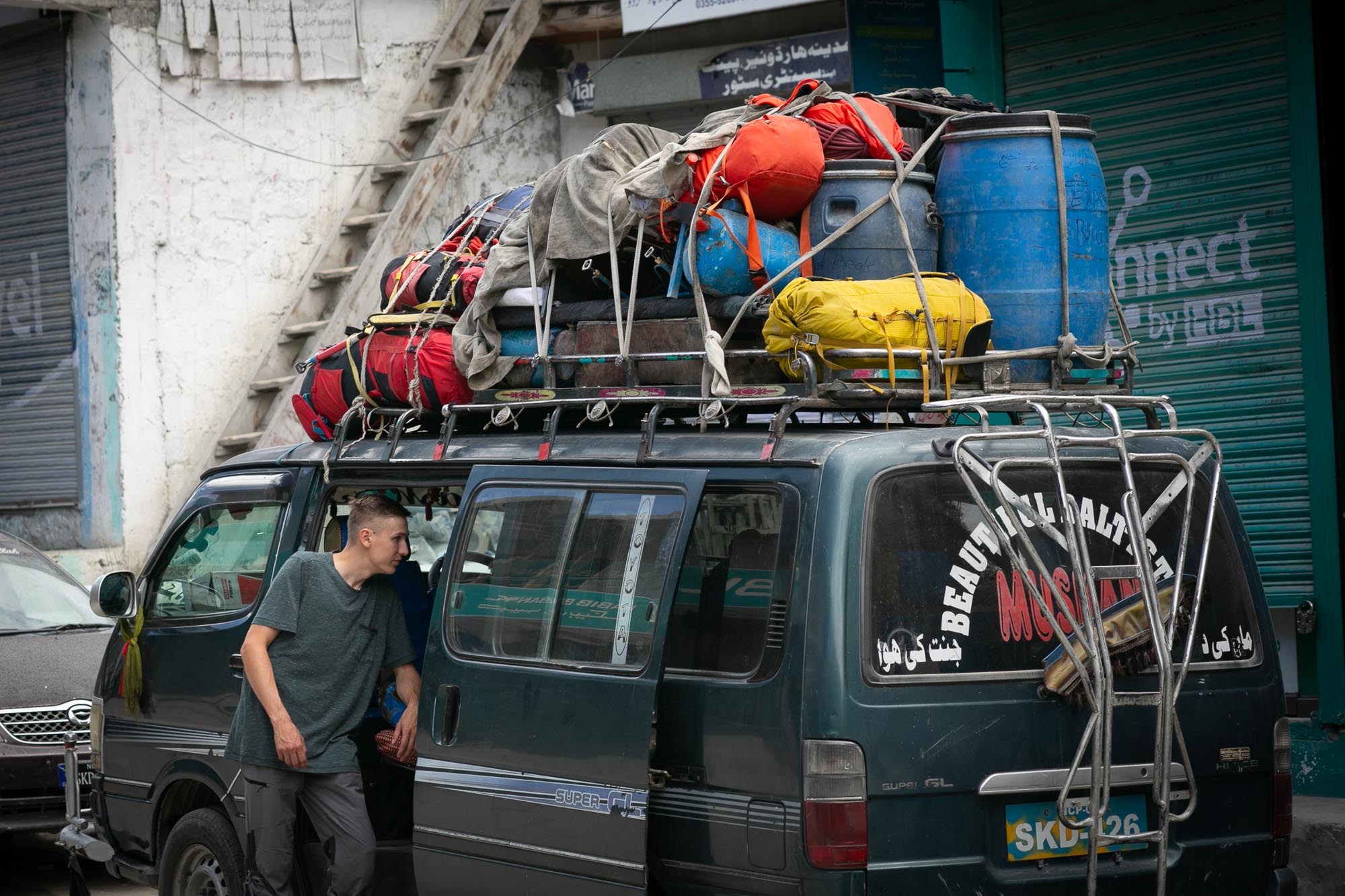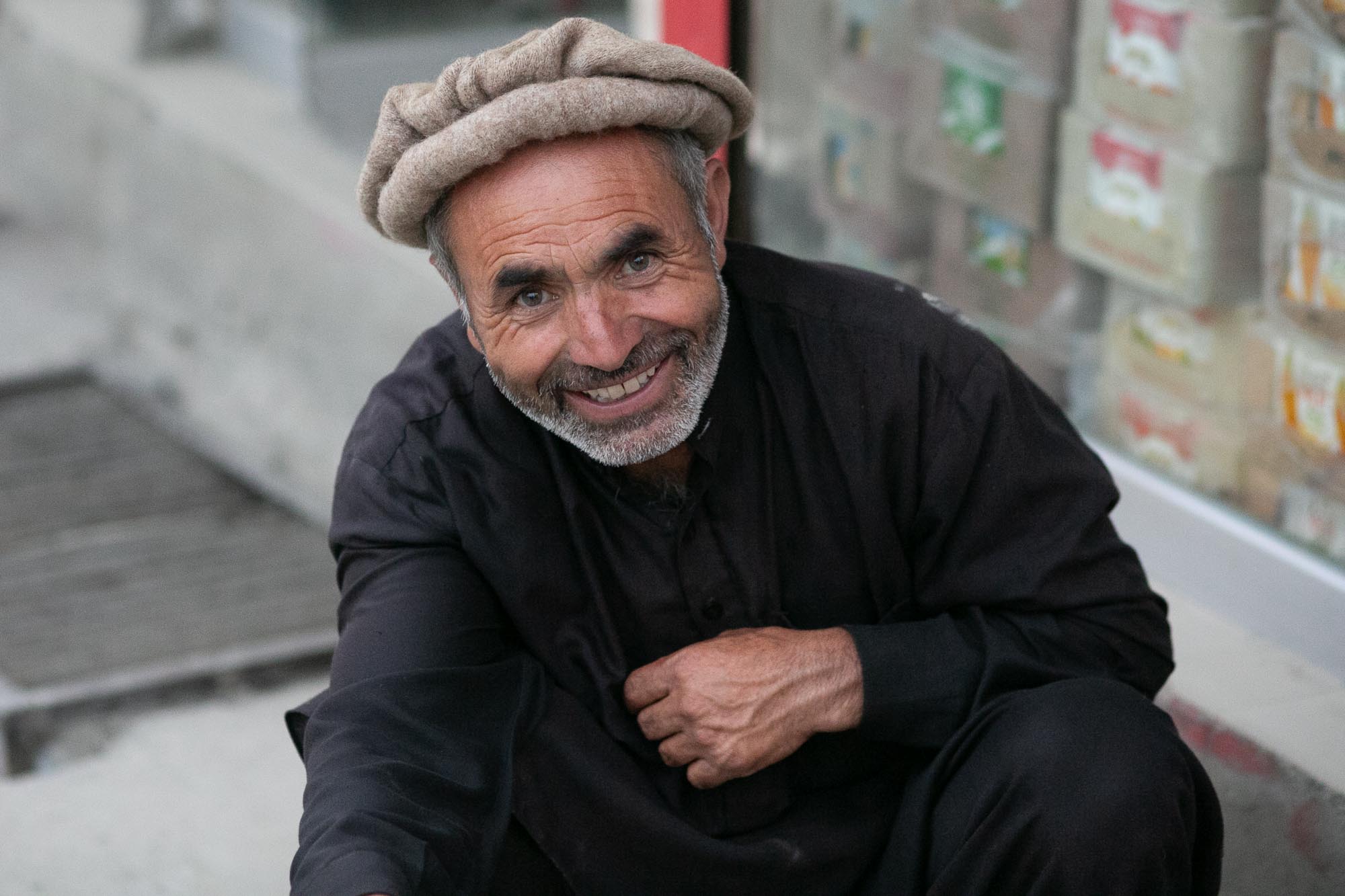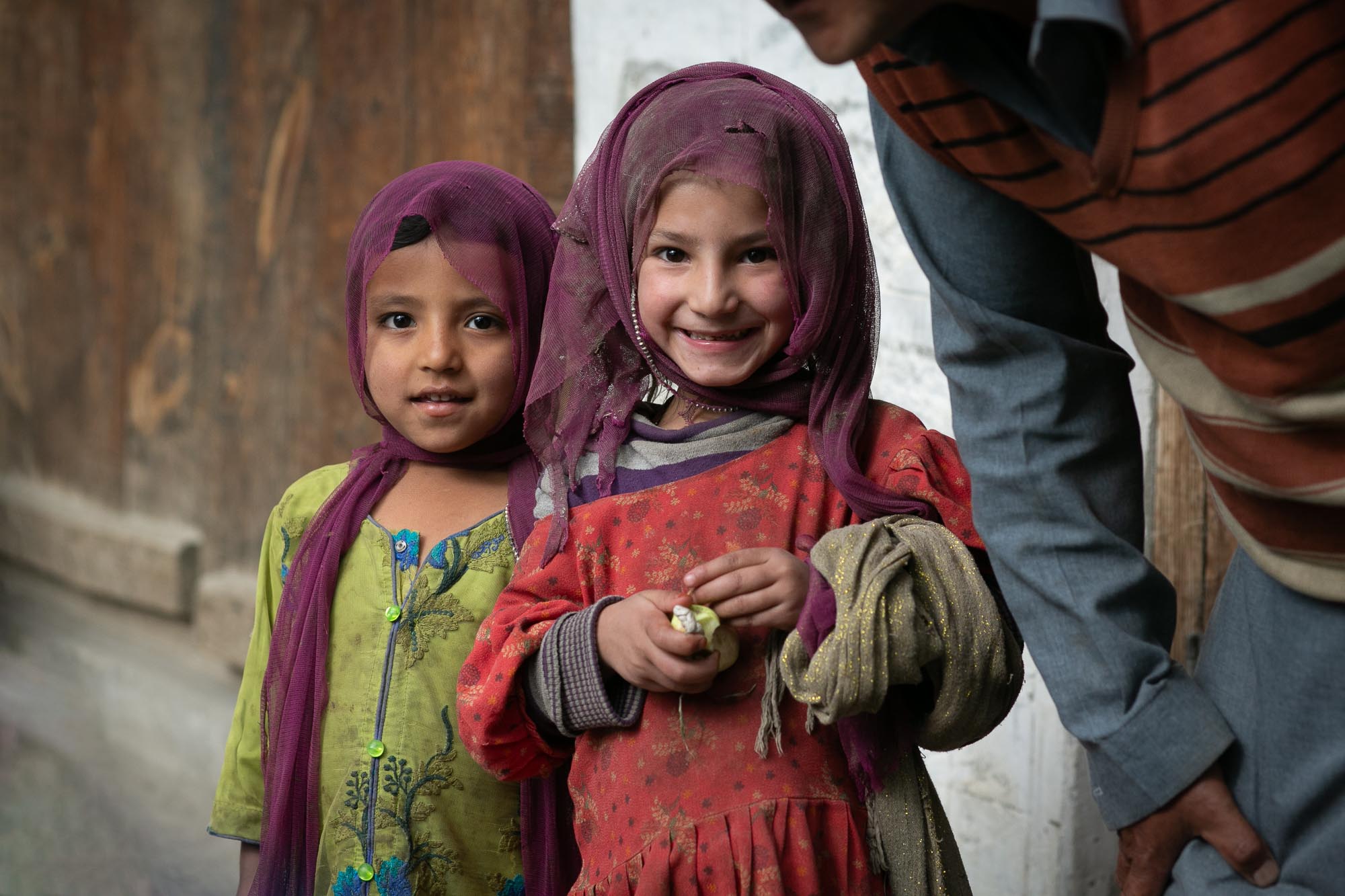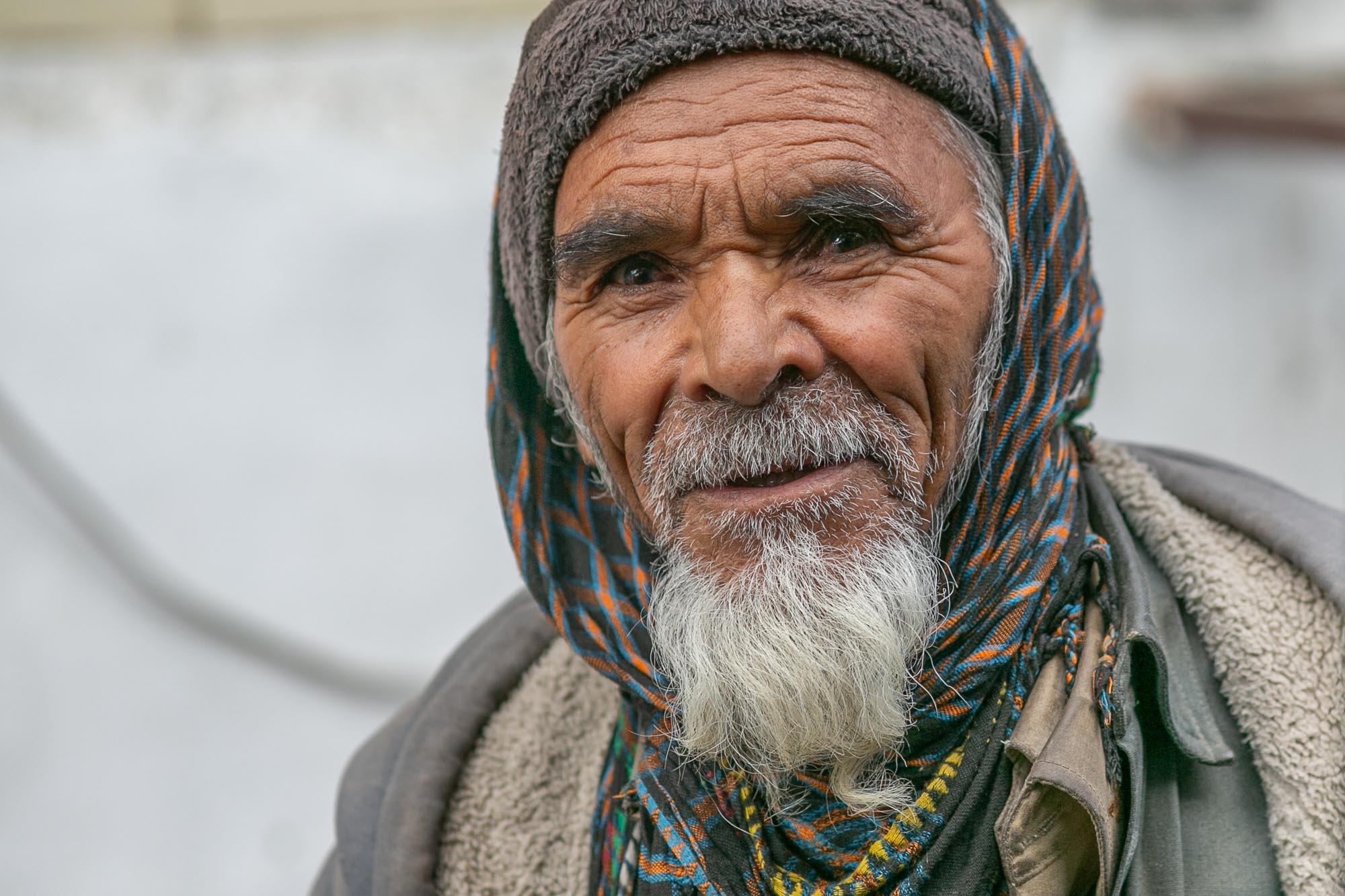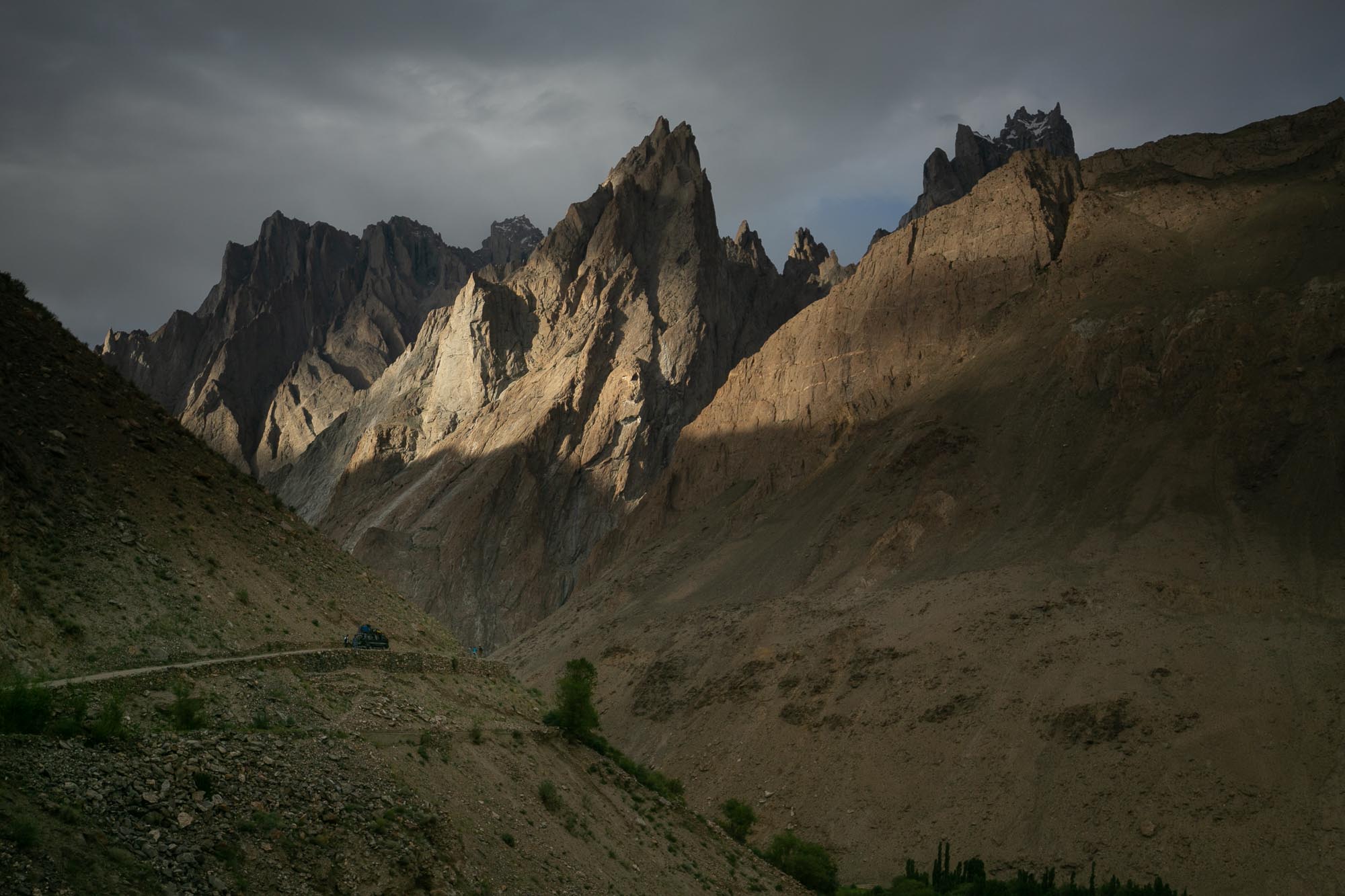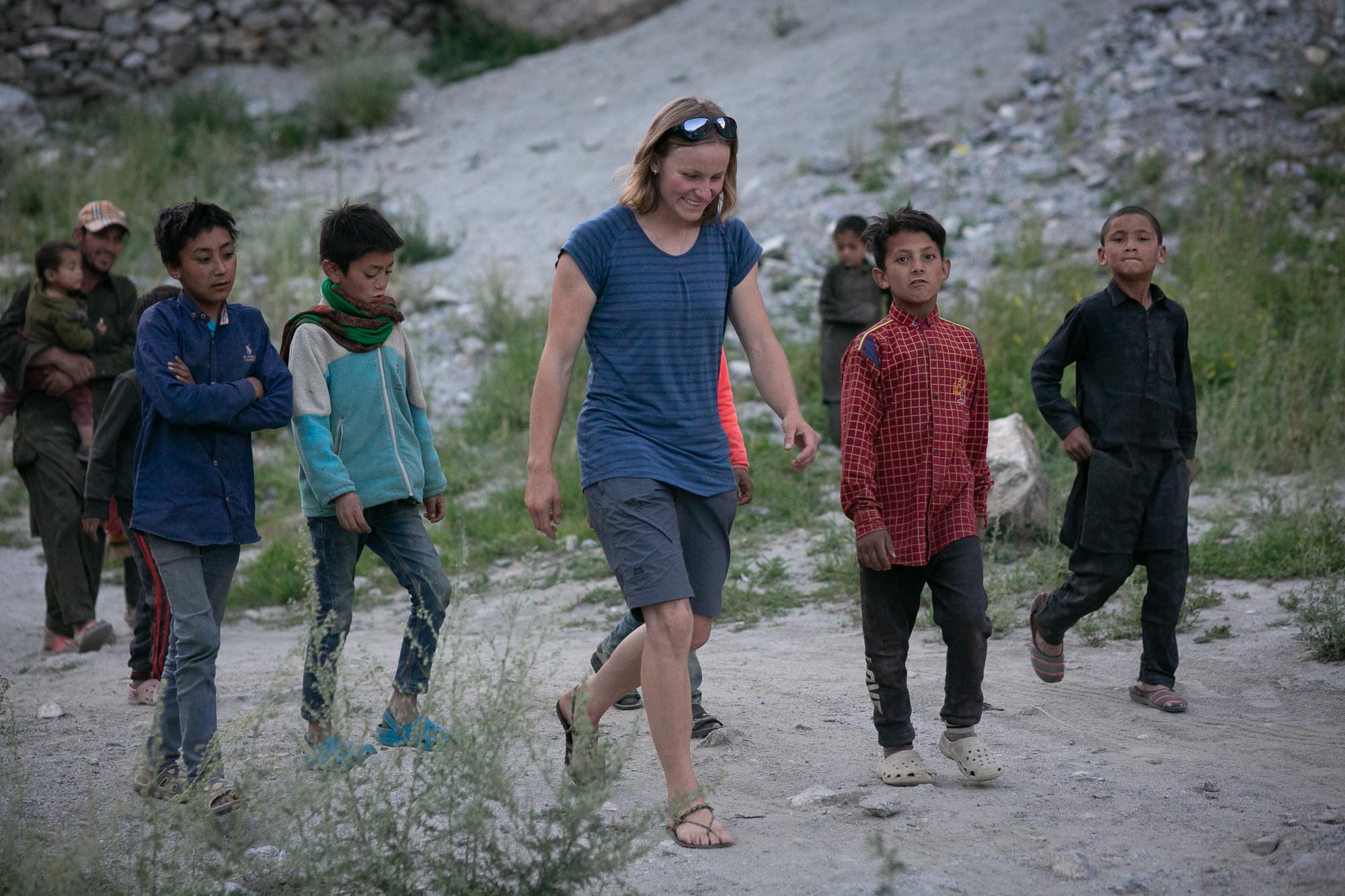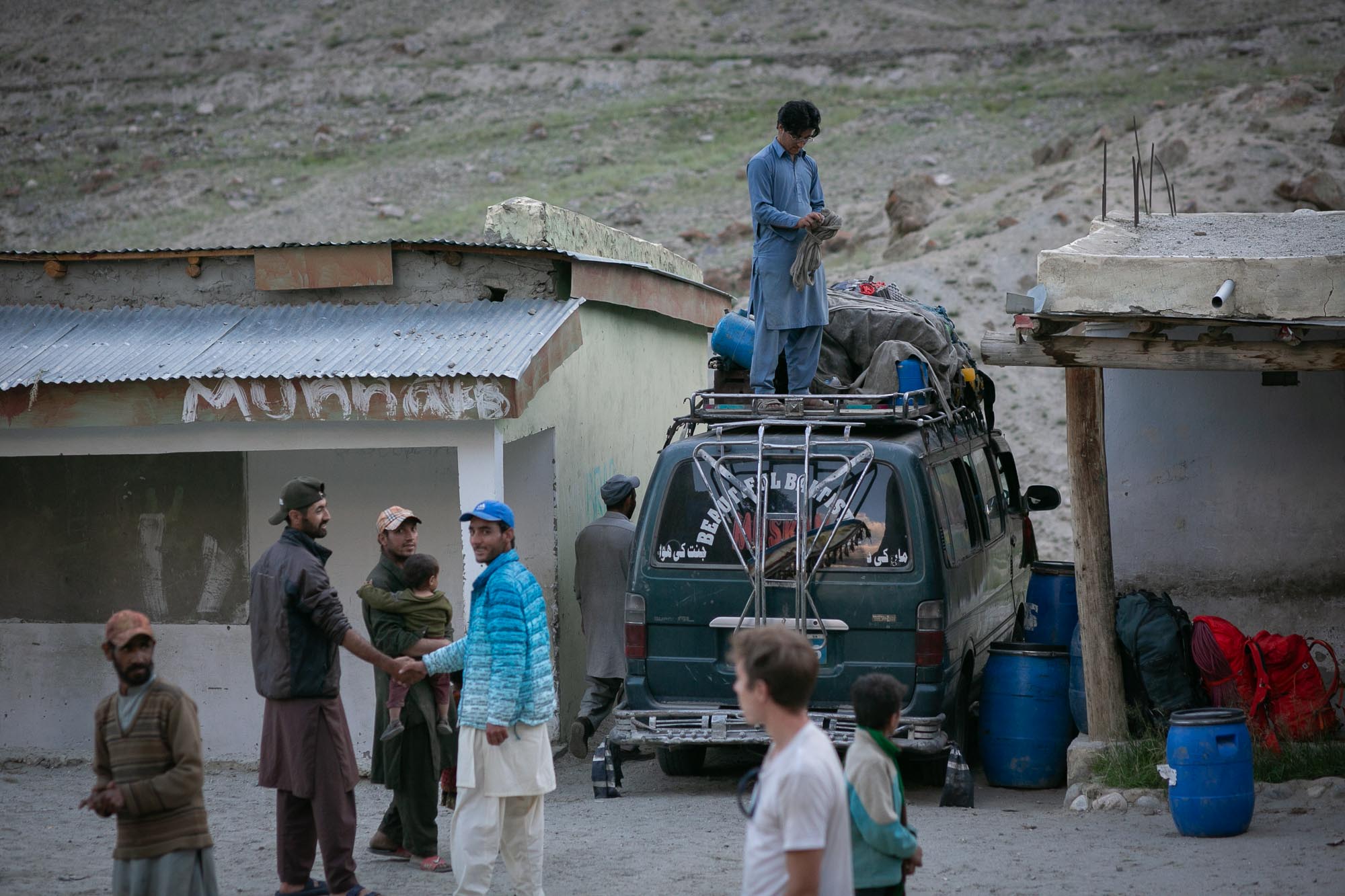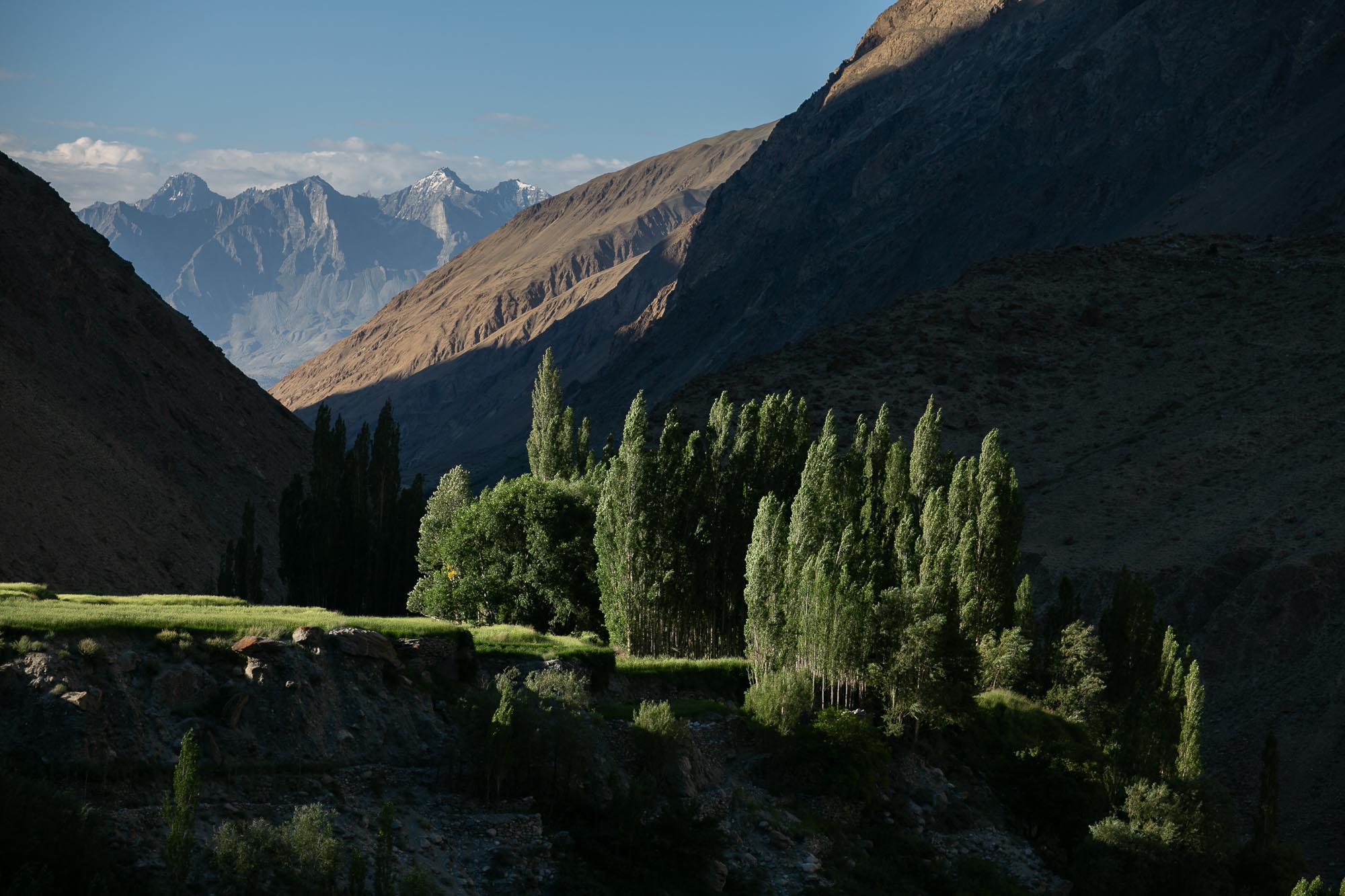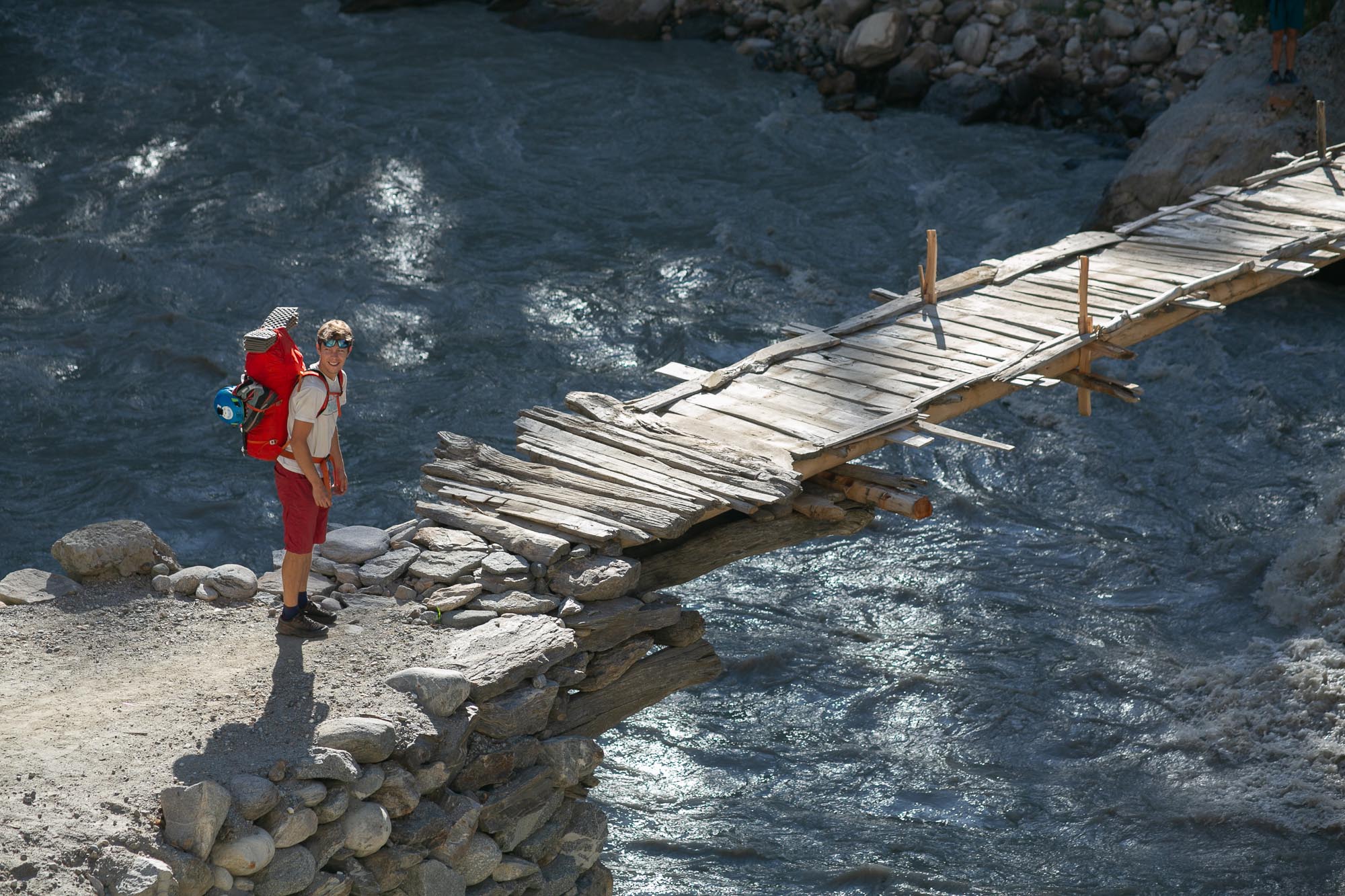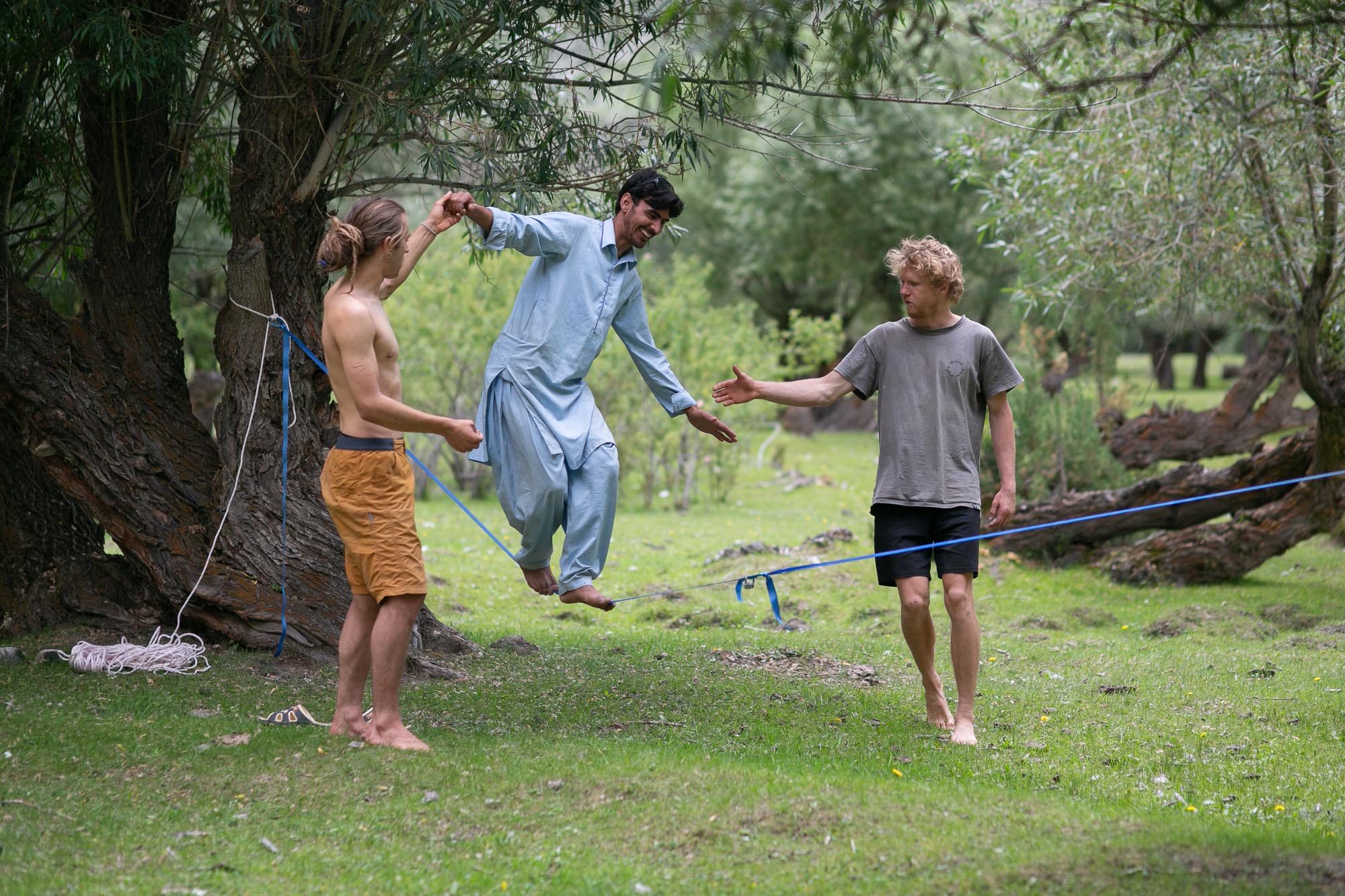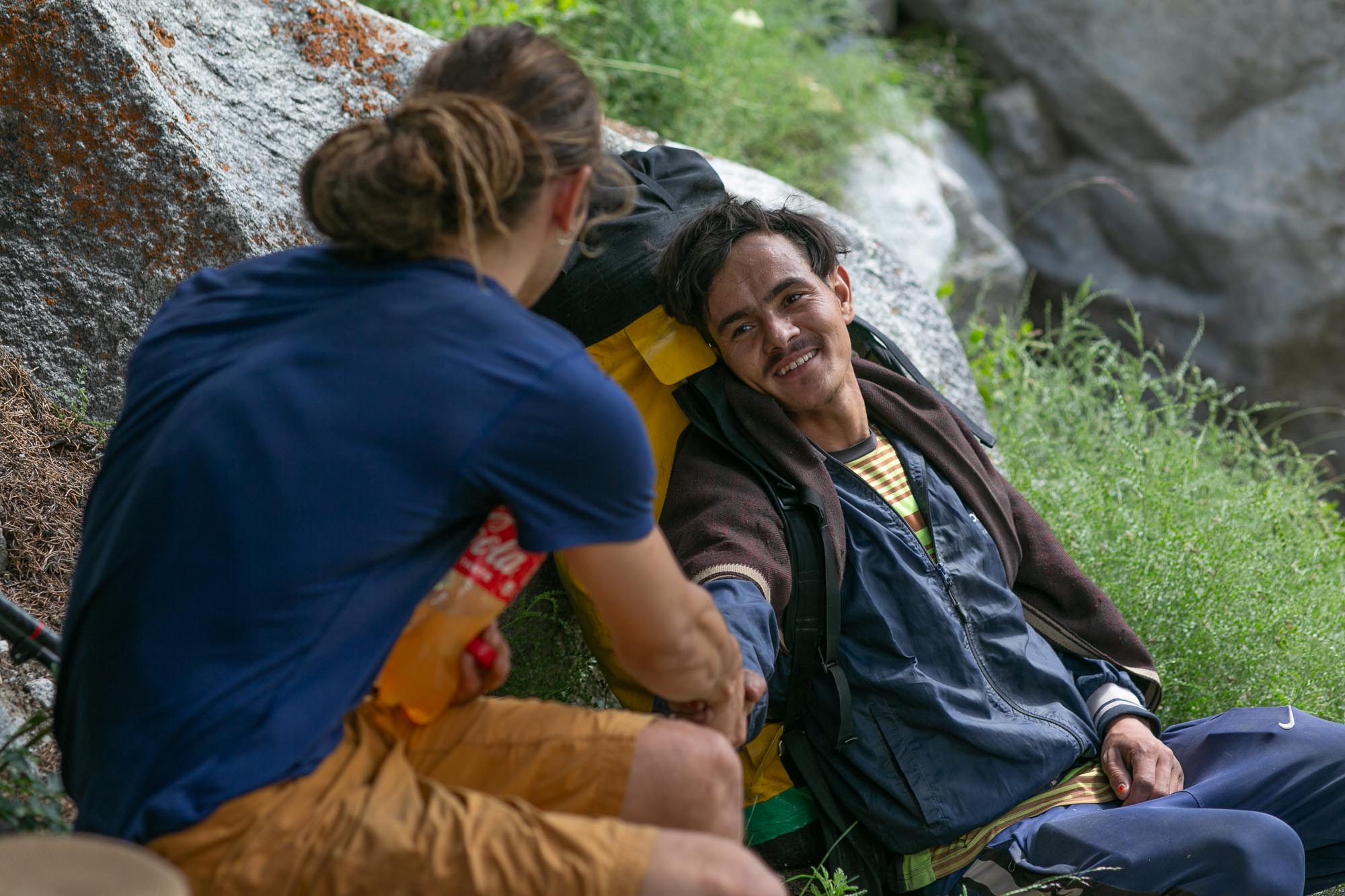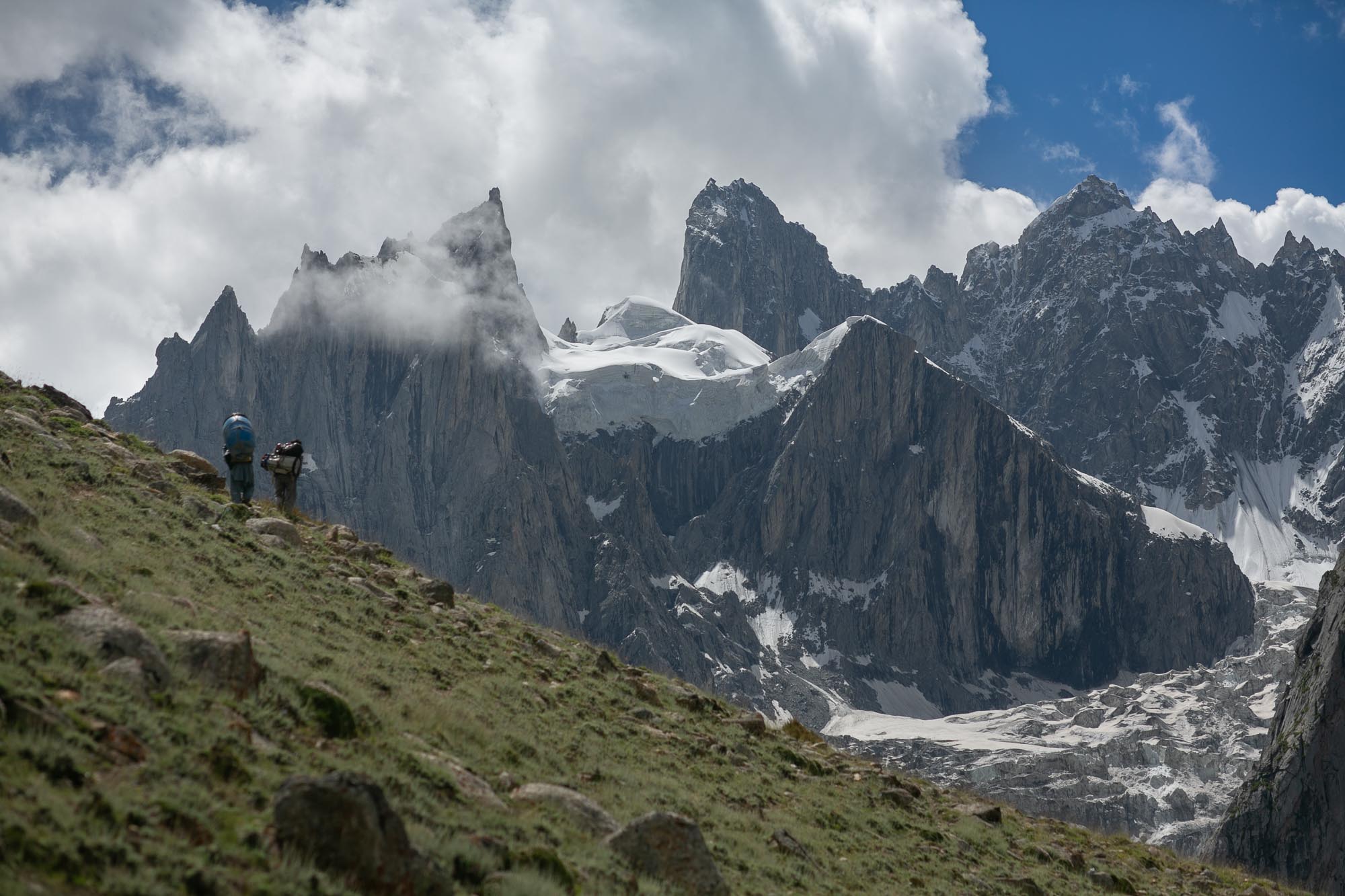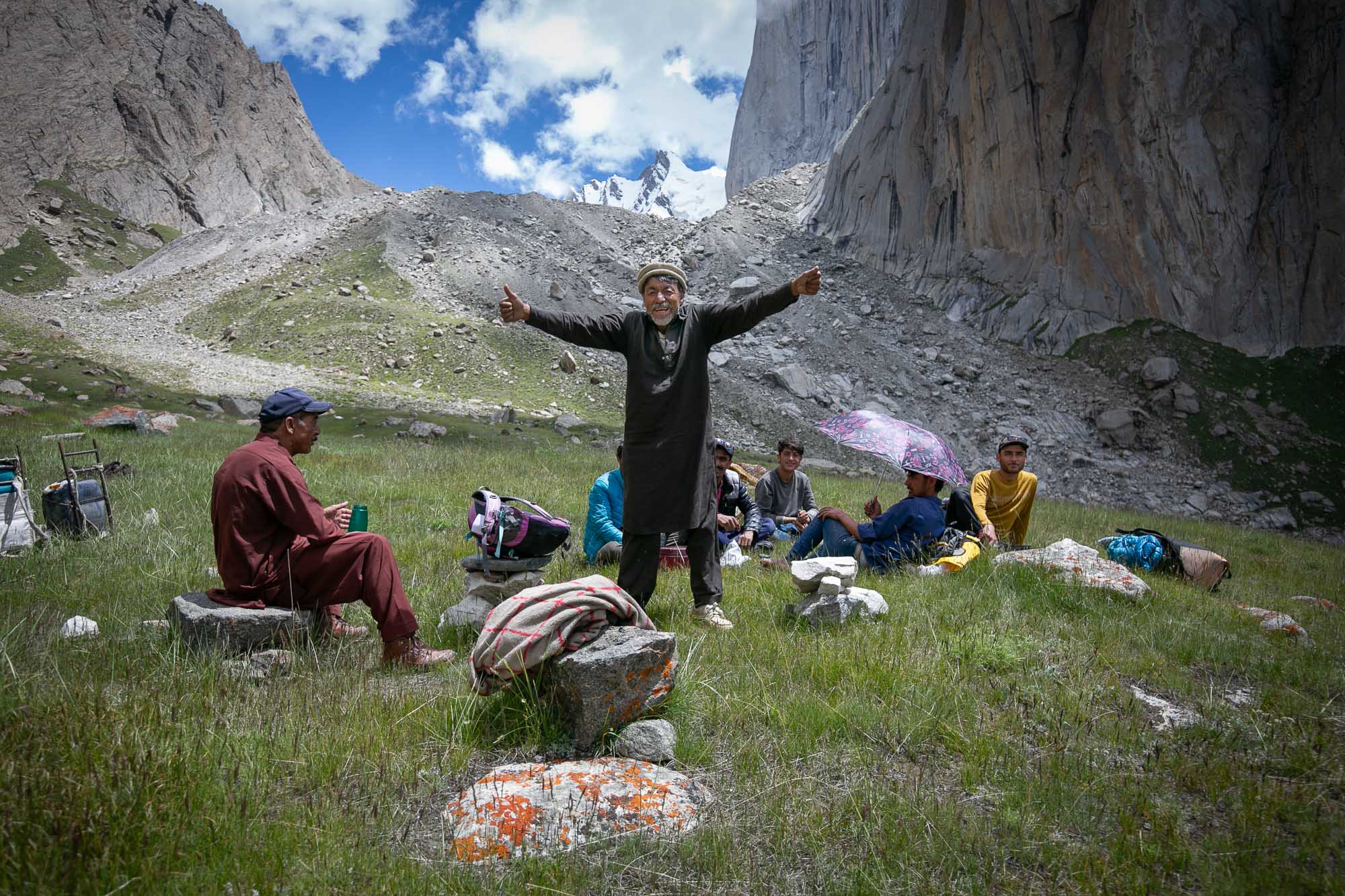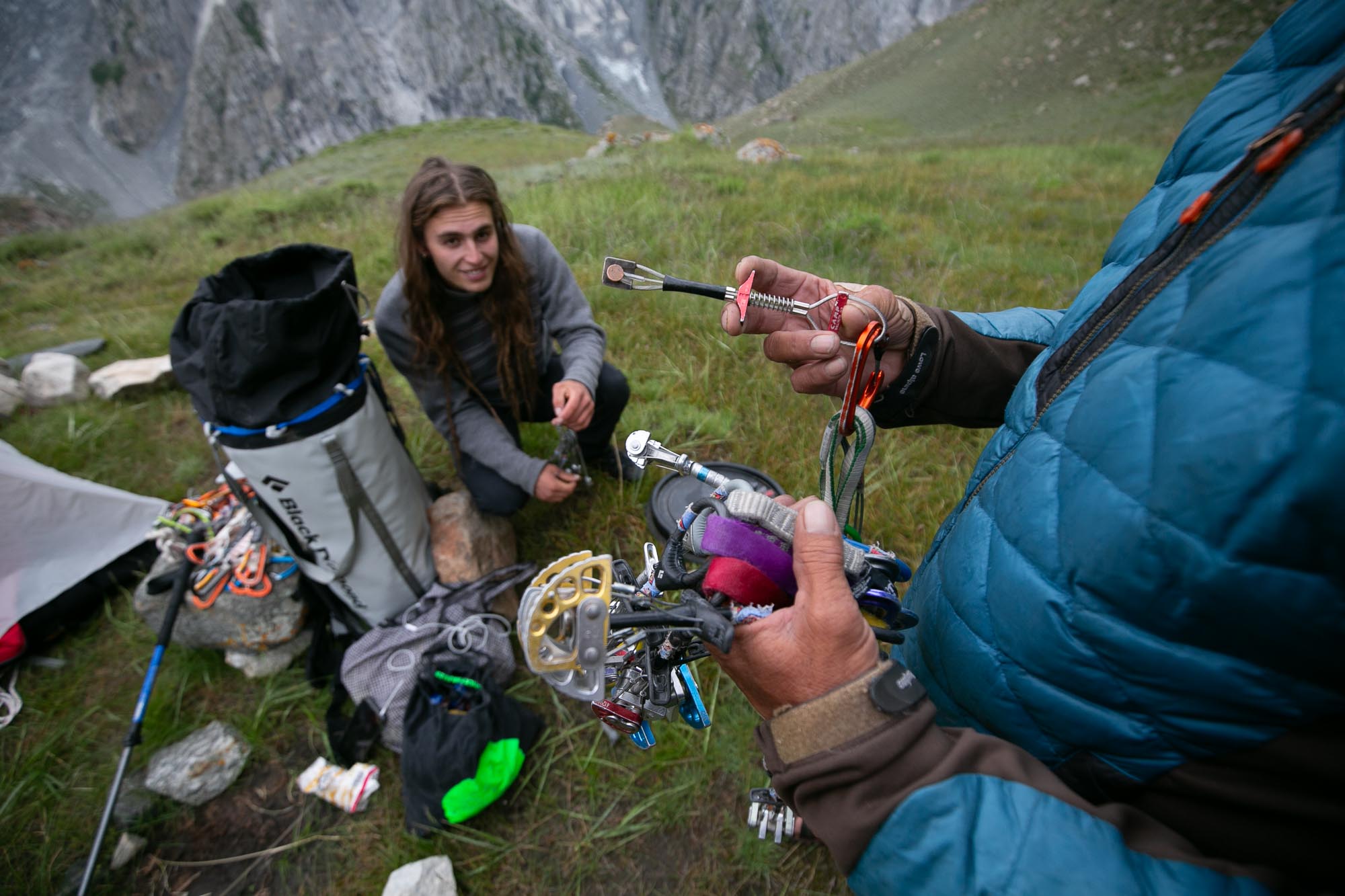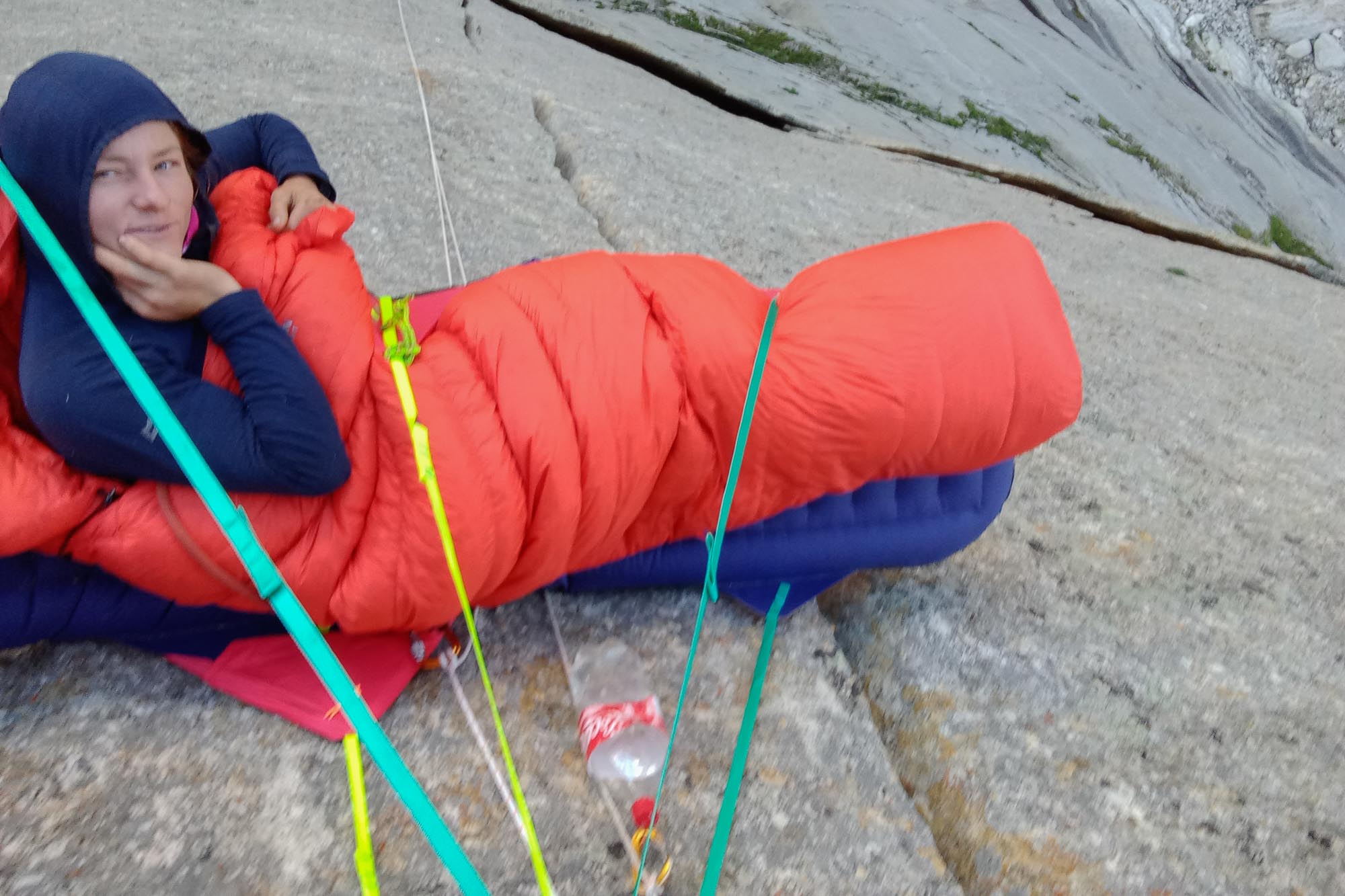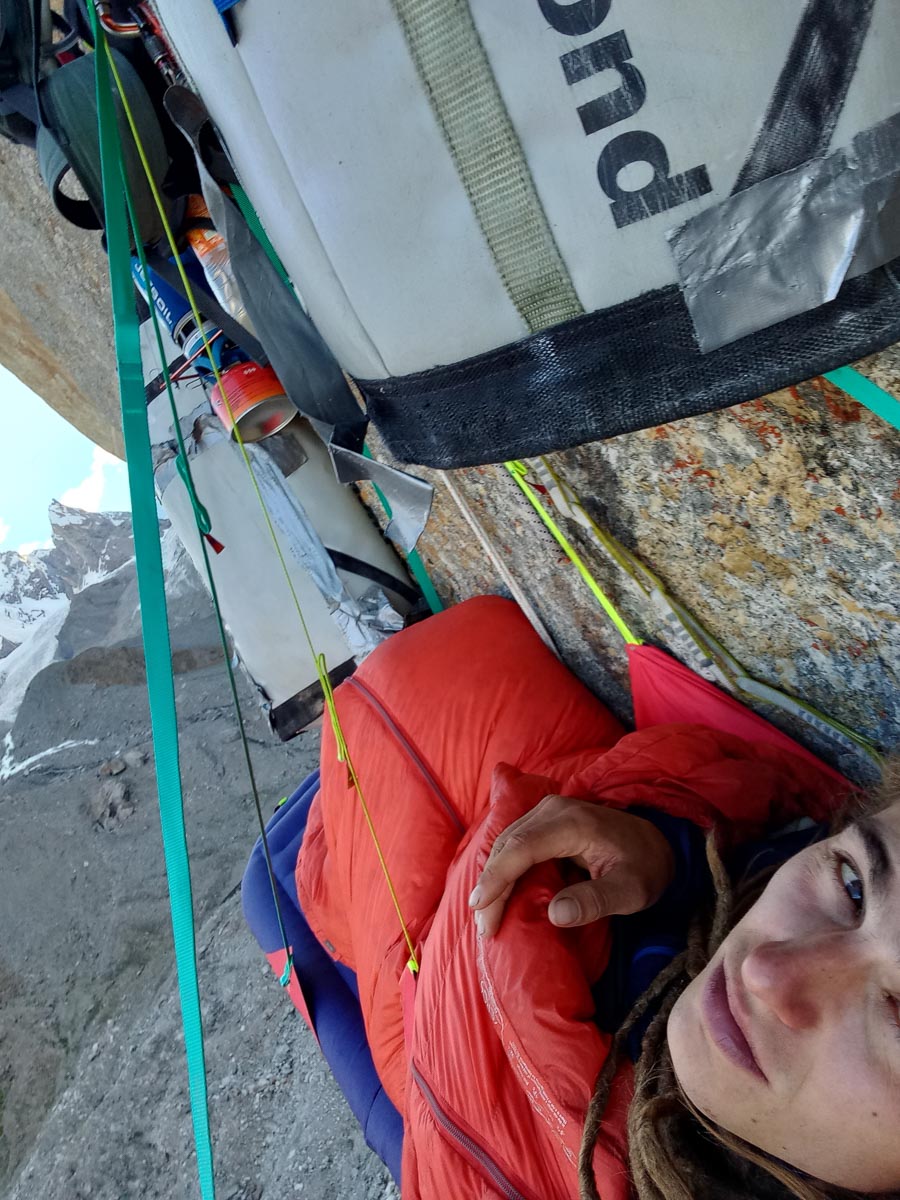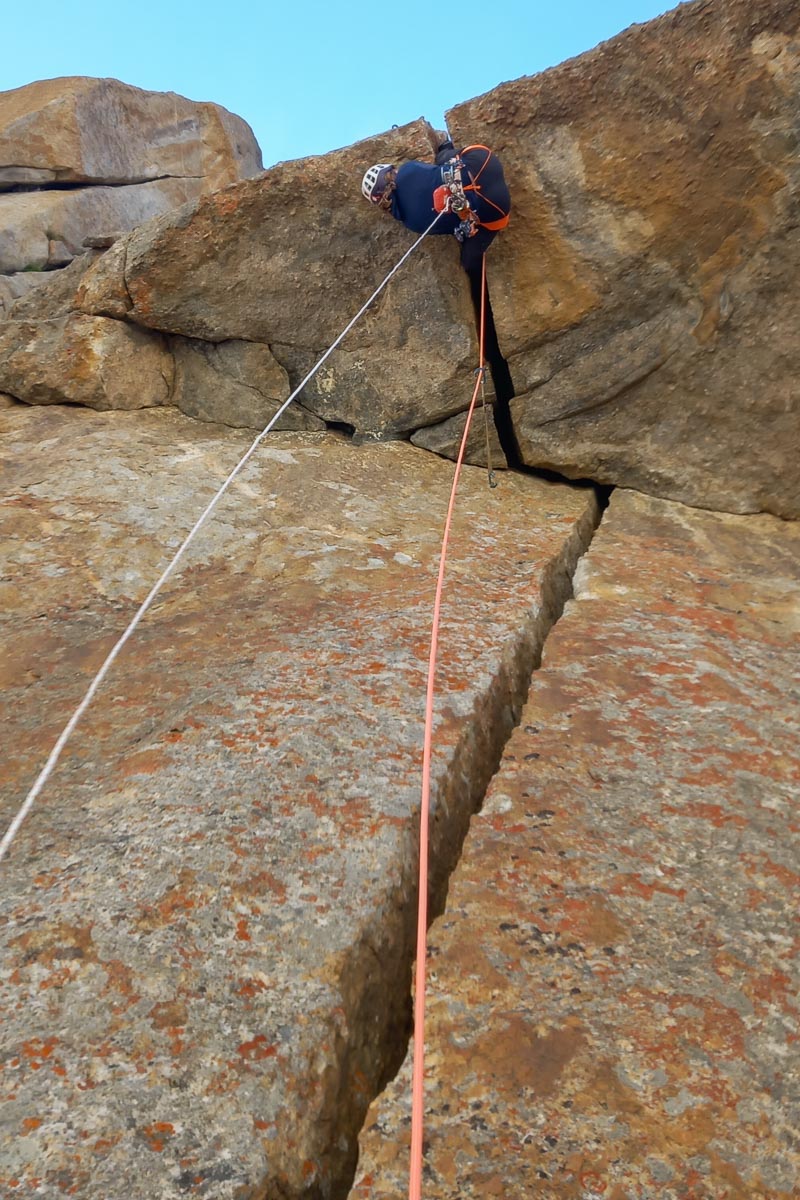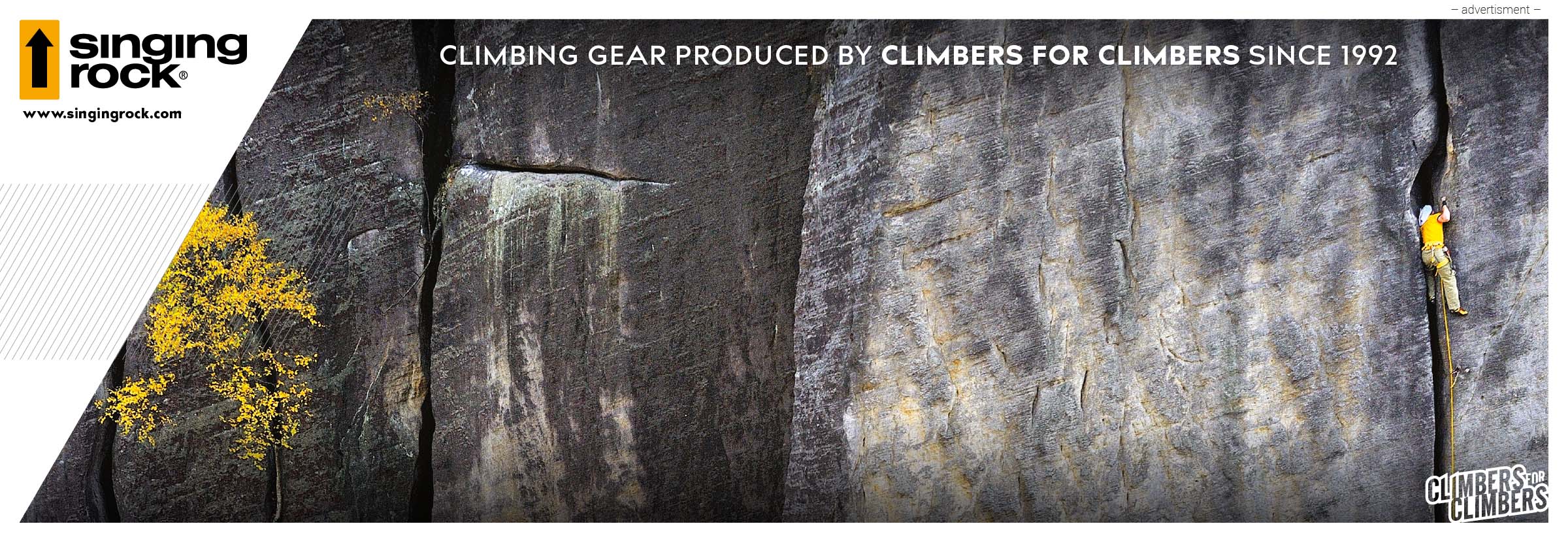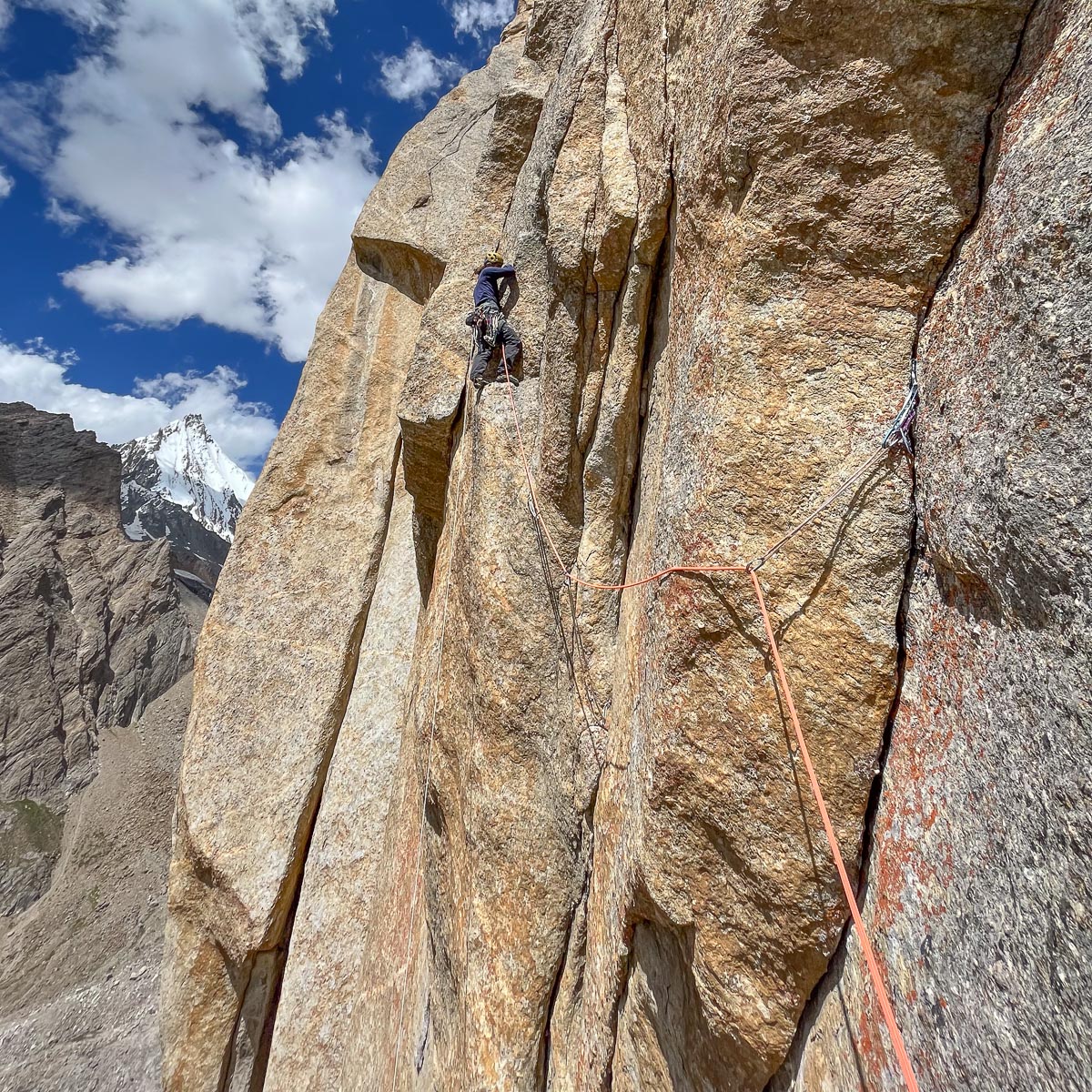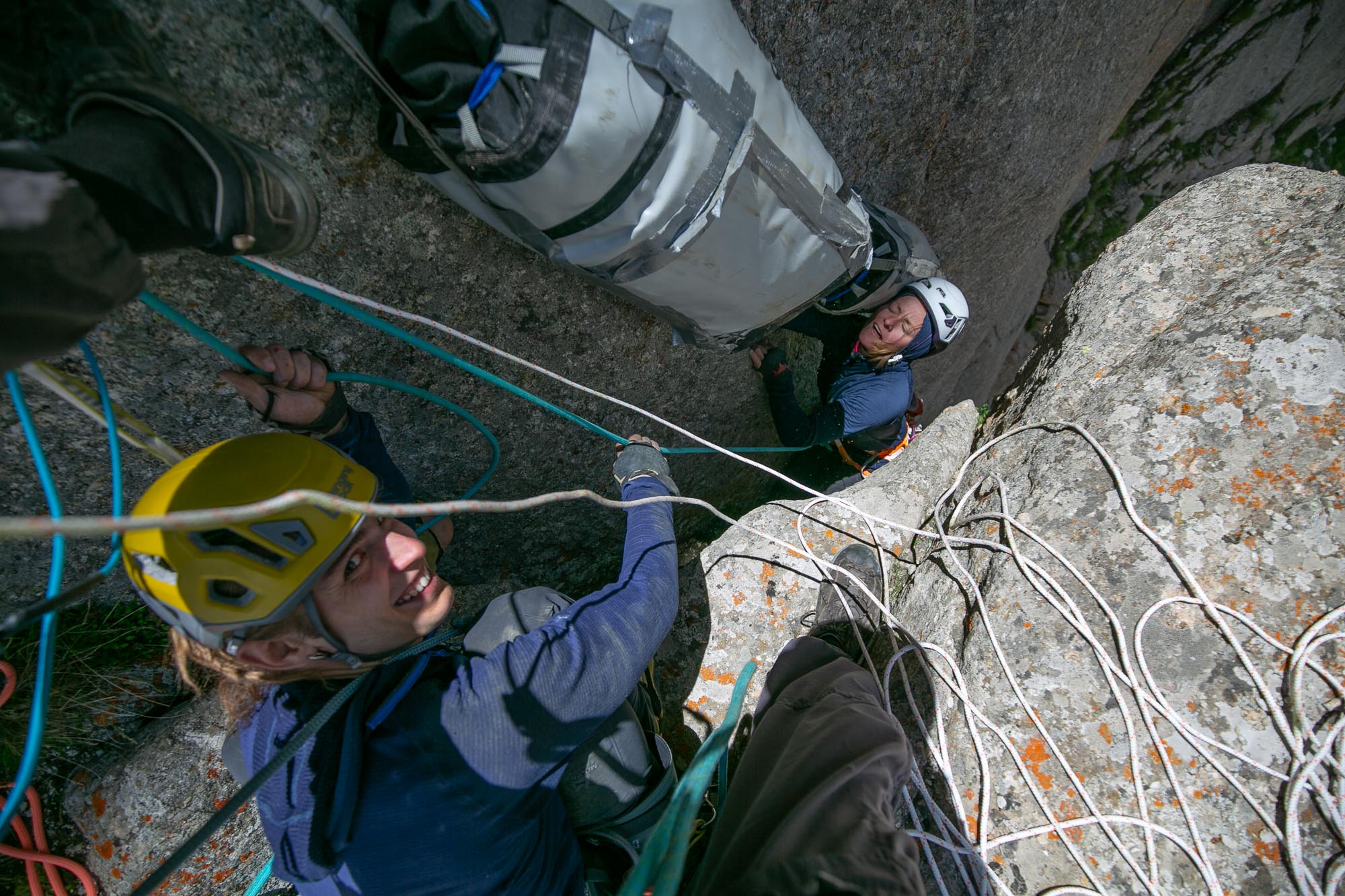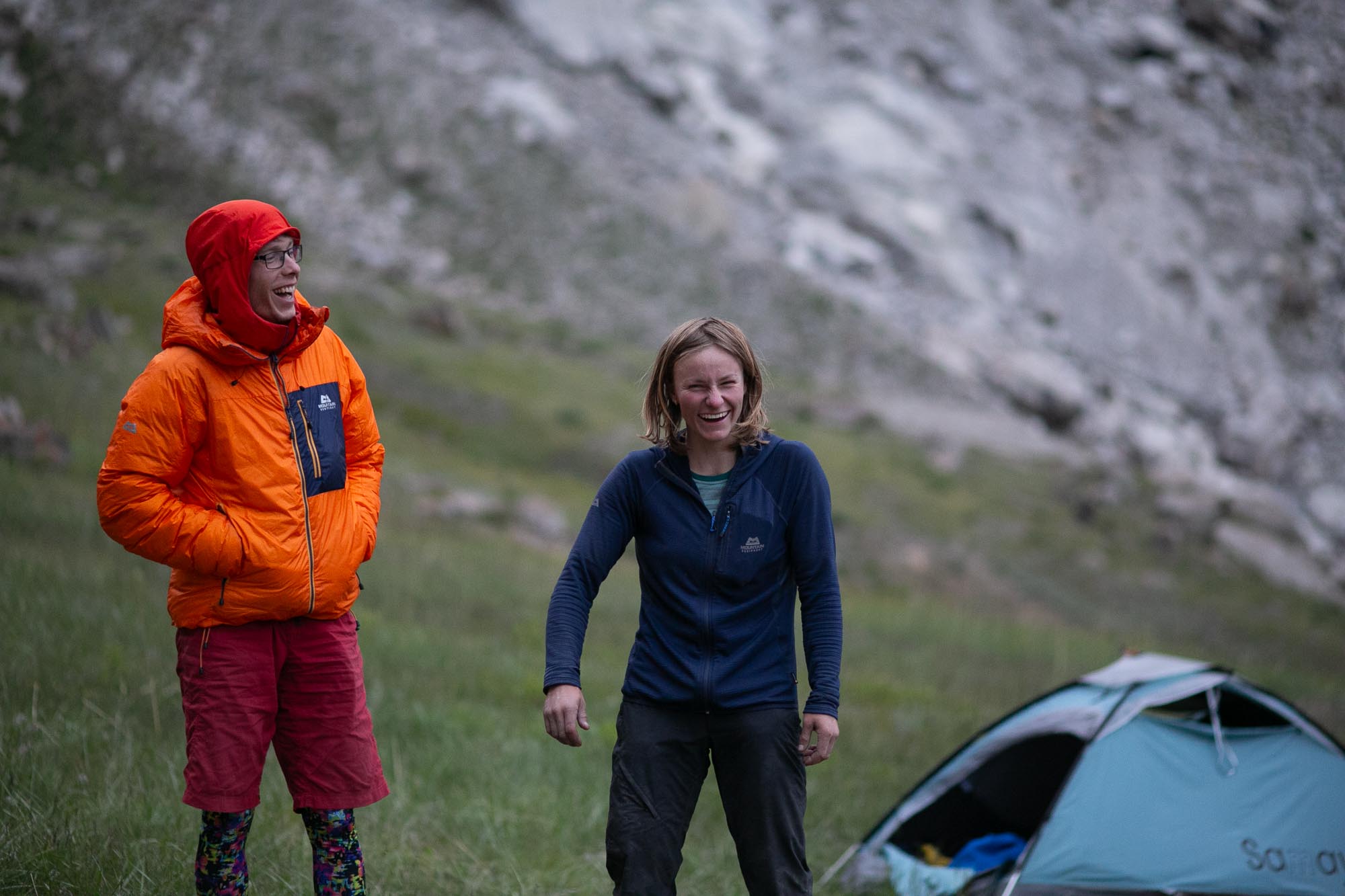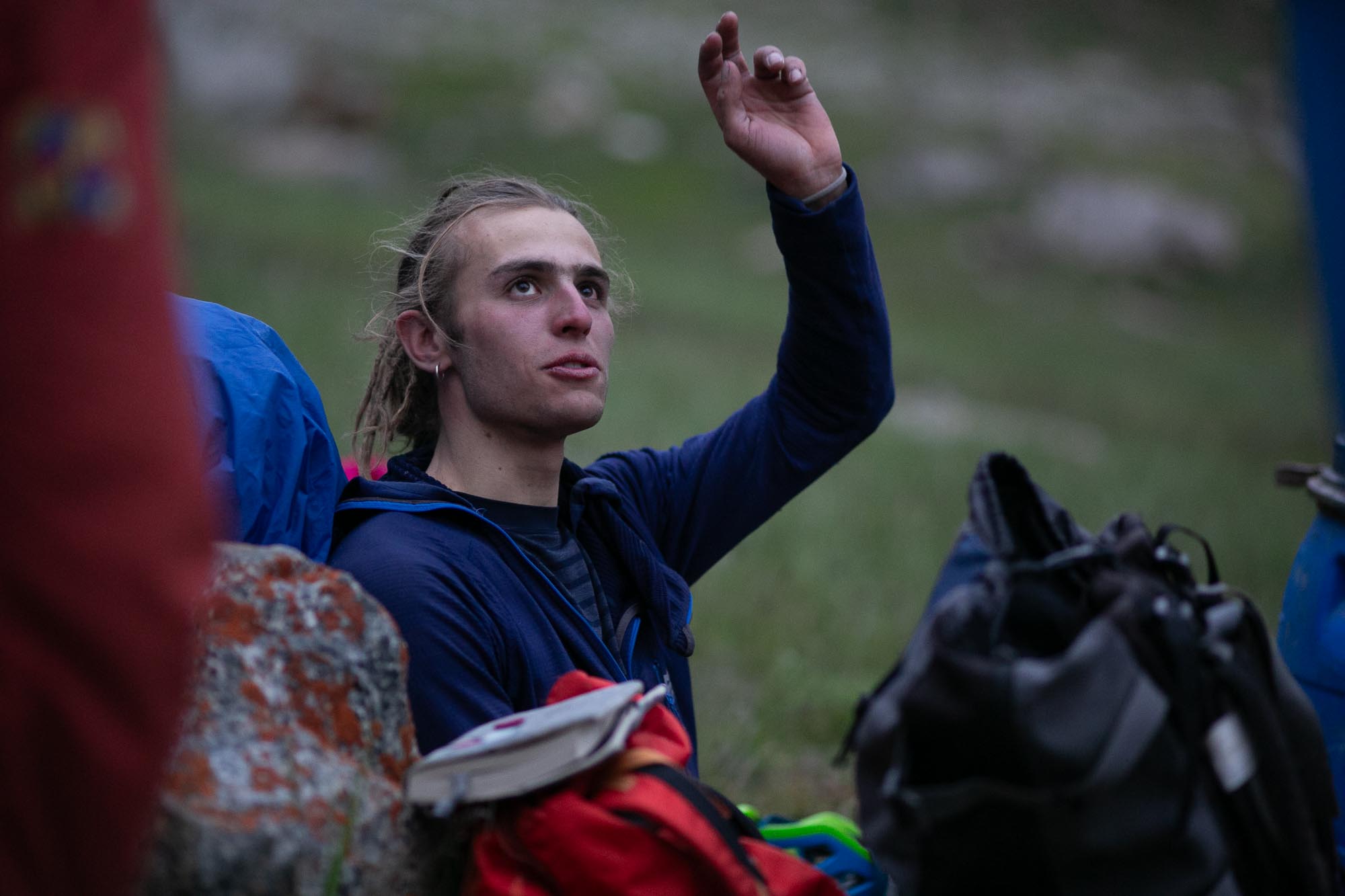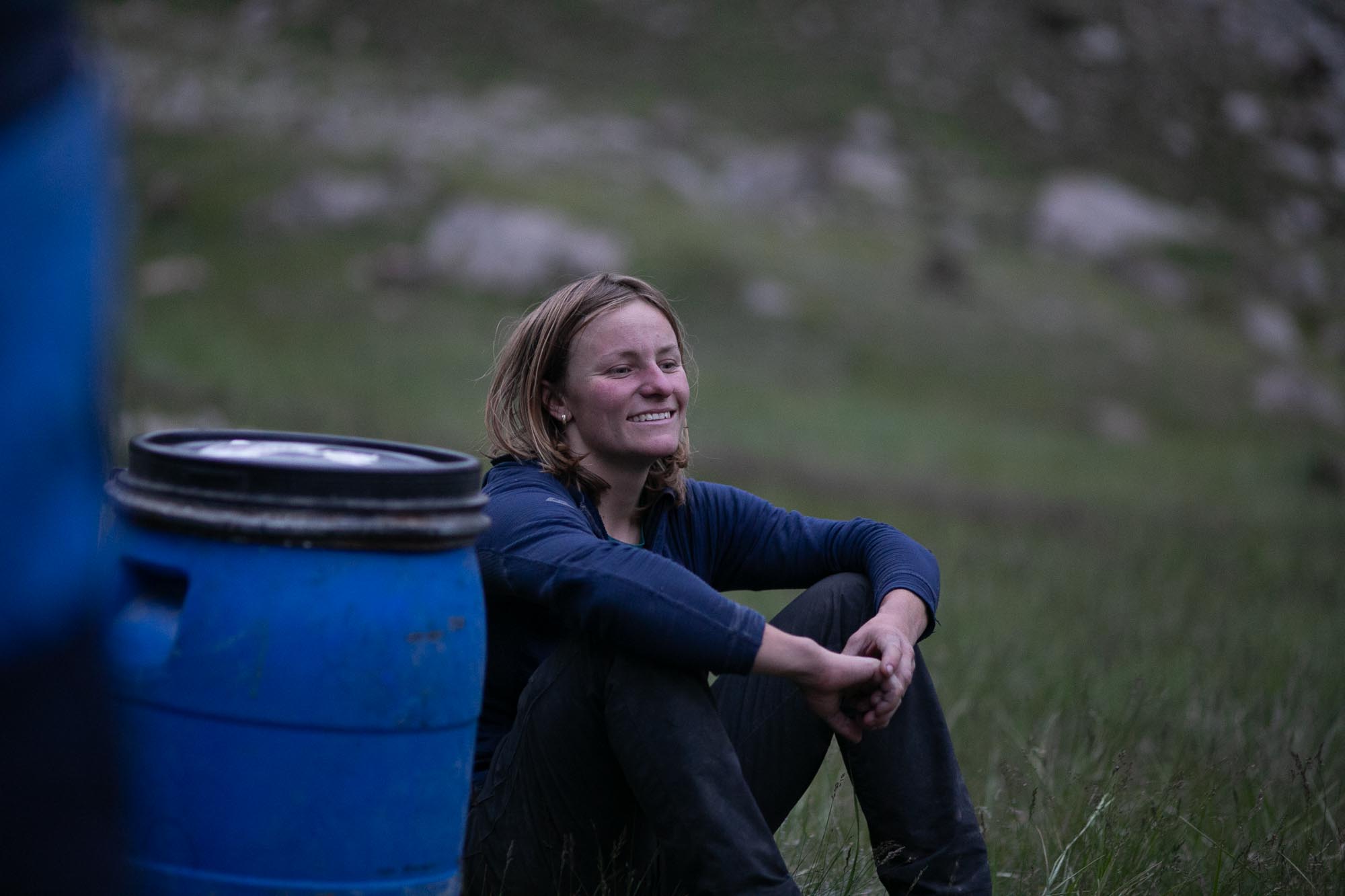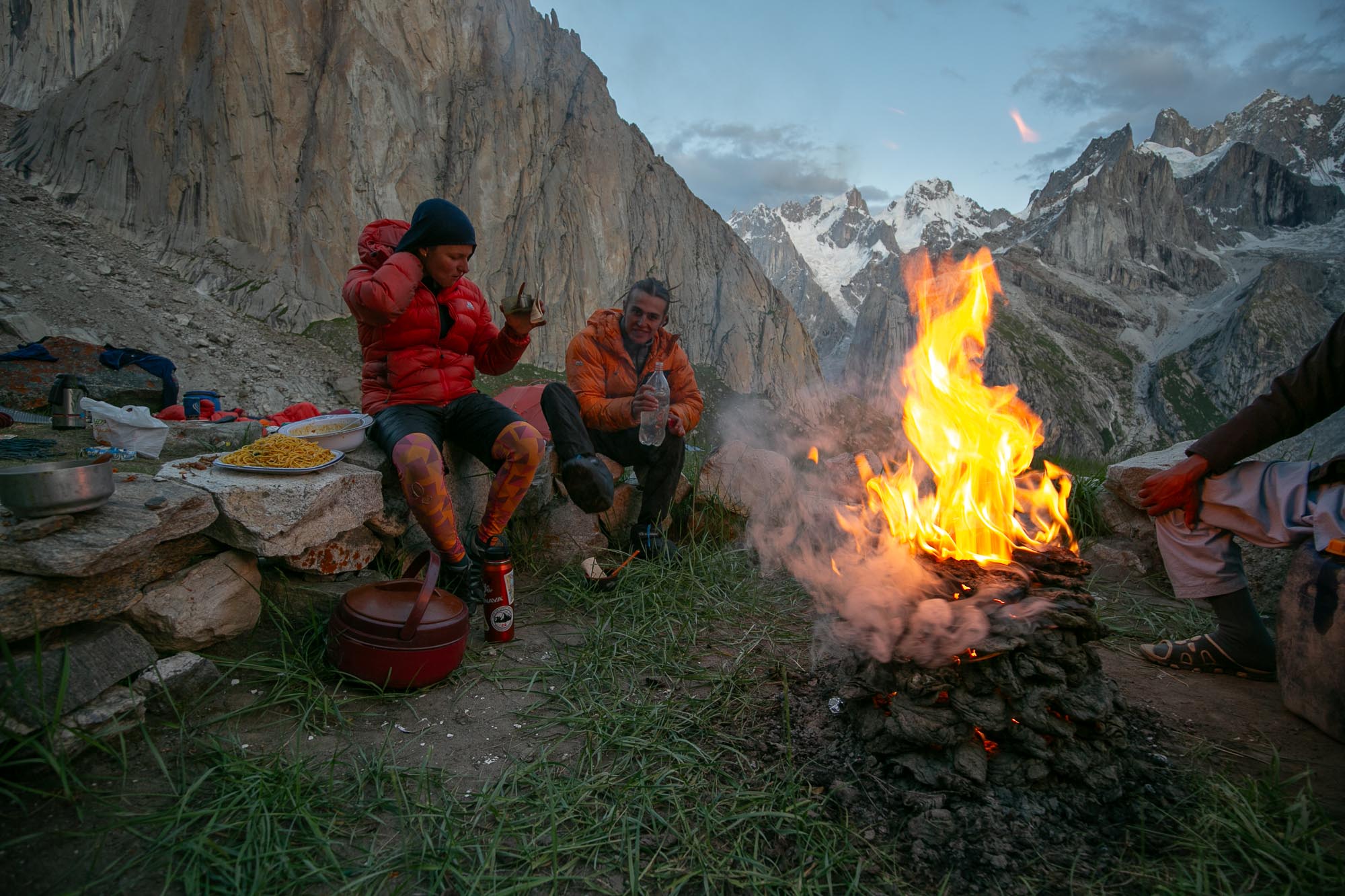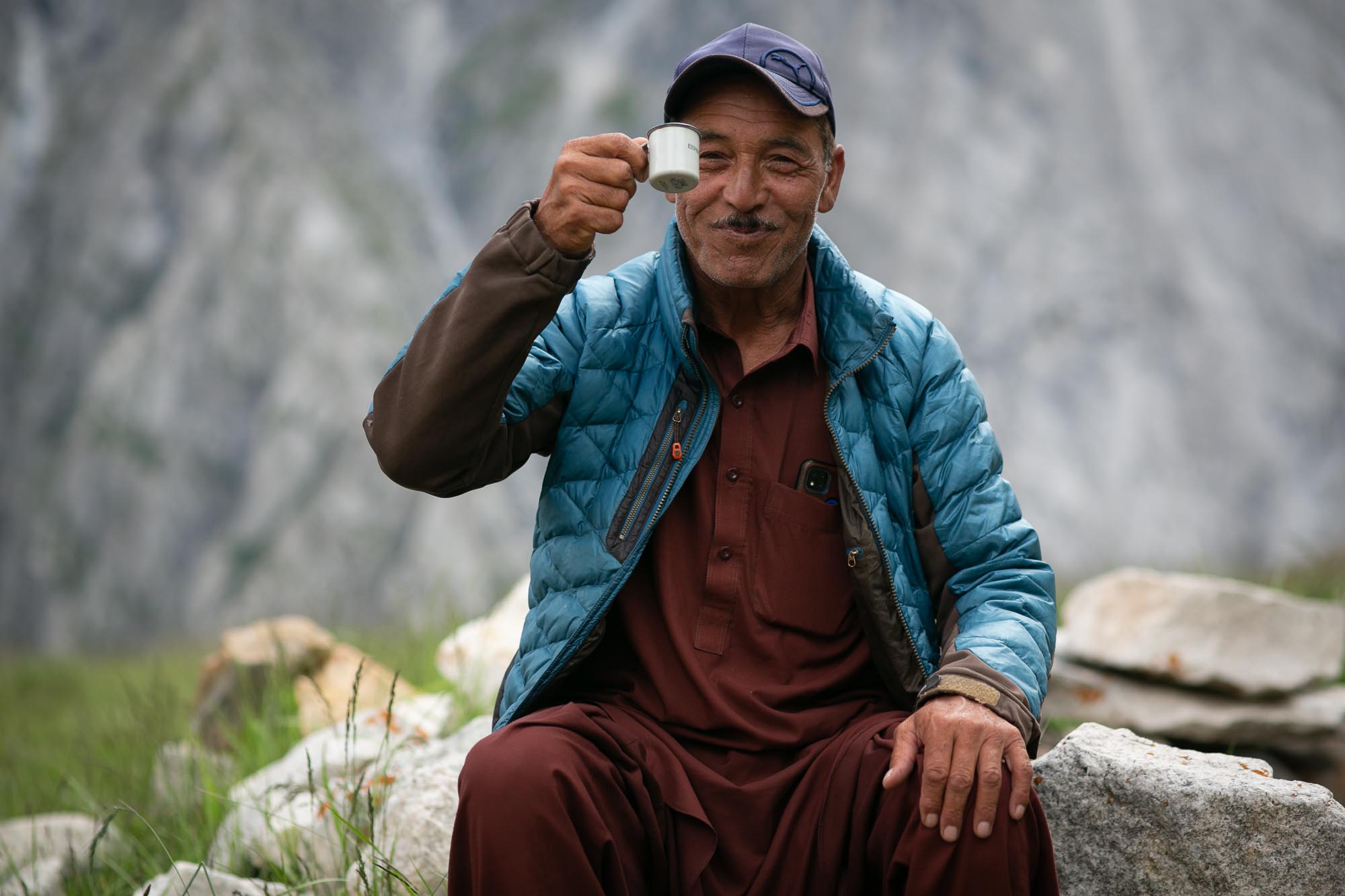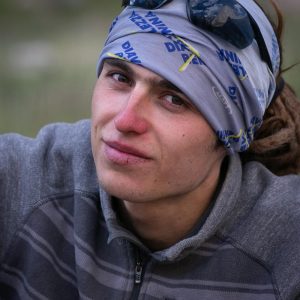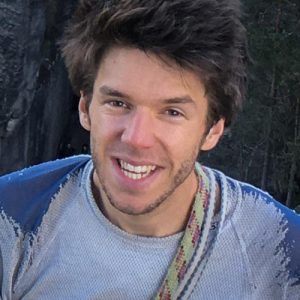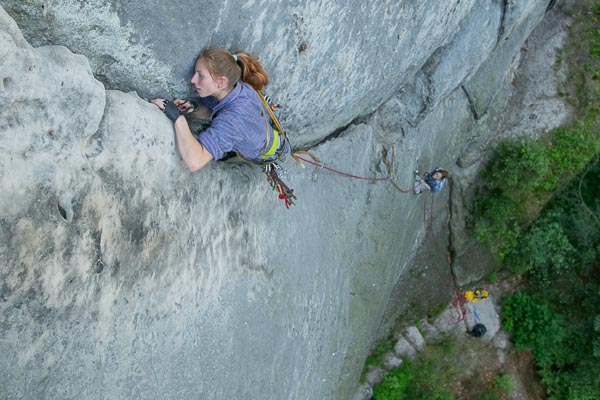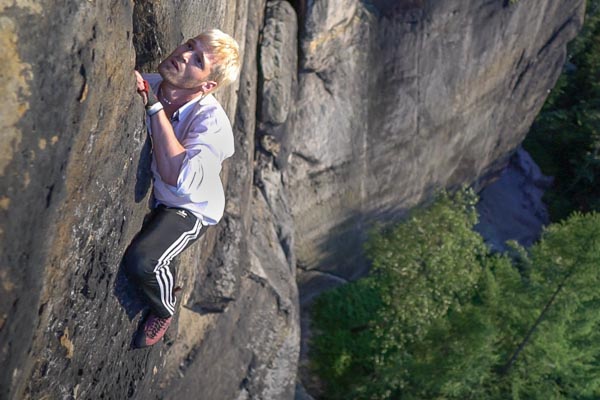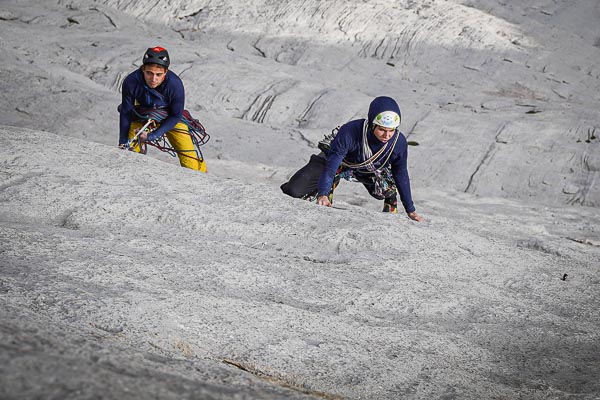BLOODY MARY
THOUSANDS OF METERS ABOVE SEA LEVEL, HUNDREDS OF VERTICAL METERS. WEEKS OF PREPARATION, MONTHS OF DREAMING, AND IT STILL COMES DOWN TO ONE ROPE LENGTH, ONE BOULDER, ONE MOVE… THAT’S THE PARADOXICAL CRUELTY OF THE BIG WALL FREE CLIMBING. INCOMPREHENSIBLE TO SOME, MAGICAL TO OTHERS.
THE SMALL CRAG OF DENBOR BRAKK
Although the crags are small, they are impossible not to notice. By the time you reach the base camp (4,300m) in the Nangmah Valley, you’ve already passed the Zang Brakk (4,800m) and are now pitching your tent about a hundred metres below the start of the climbs. If you turn around, the first thing you will see is the triple summit of Denbor Brakk (4,800 m). But your attention is immediately drawn to the mighty mass of pale granite in the background which resembles a freshly plastered wall. This is the Amin Brakk spire (5,800 m). It is its 1,300 m high wall with a snow cap that alerts you that your wall is a dwarf every time you look over in its direction.
But it also makes it clear that you can’t get up it. So you accept, with a little bit of embarrassment, that you have to go grind the cracks of the smaller peaks; or you stop caring about rock climbing altogether and go try the higher mountains that hide under the expensive white coat that some of us like to caress and uncover.
The whole valley is actually a disco with several floors where you can have all kinds of fun and dance. Each floor has its own dress code and rules. I really liked the middle floor, the rock floor, so I’m going to write about it. Specifically about climbing the “Bloody Mary” route (7c+/8a, 450 m) on Denbor Brakk, first climbed 19 years ago.
THE WAY TO BC
After a few days on planes and a trip in a compact Toyota, we find ourselves in a schoolyard in the village of Kanday, where children are curiously watching and circling us. When the adults aren’t looking, the children are quick to seize the opportunity and beg for chocolate or money, which they probably learned from previous expeditions. When the adults are watching and feel that their little ones are too annoying, they don’t hesitate to throw a dried poo into their midst or threaten them with a rock. The children then fly away screaming like a swarm of flies.
Our cook, Afzal, is pitching his tent and cooking dinner for the first time. It’s not very glorious, but thankfully the standard has gone up during our stay. We wake up early. The kids want the chocolate, the guys the money for carrying luggage. In the morning, interested porters descend from the surrounding area and there is an auction for individual 25 kilo packages. It’s not without a bit of a fight – between the locals.
After sharing the weight, we head towards the promised Nangmah Valley. We pass through neat, hand-cultivated fields to more rocky slopes above the river. A little after ten we arrive at a truly picturesque grove, where we spend the rest of the day and night to acclimatise, only to climb steeply the next day to reach base camp.
We have fun with an improvised slackline, reading the Czech writer Bohumil Hrabal together and watching the “catch the cow” action. We have decided to take up the offer of killing a small cow for meat. At first they couldn’t find a suitable one, then they found one, but it escaped, but eventually they managed to tie the animal up, kill it and expertly butcher it. An interesting experience. All in all, the journey from Prague to base camp took six days…
TO HOLD A CLUMP OF TURF
At the base camp, I immediately ran ecstatically with my rented binoculars to check out the walls and our route. Without my pack I jumped around on the rocks and enjoyed the movement. With the lens glued to my eye, I sigh excitedly to myself and whisper, “Those are the cracks, man! This is going to be awesome, and look, there’s a free line and a crrrrrack, wait, from the bottom to the top! Unreal!” In the evening, soaking wet, I return to the base camp for a dinner. It is the first and, with one exception, the last day when it rains and when I feel somehow sick from the altitude.
The very next day we pack up the haul bags and head for the base of the Denbor Brakk wall. We have to solve the problem of a wild glacial river that doesn’t look suitable for a crossing, and certainly not with a load on its back. After a nice and dry walk, in the afternoon, we finally stand under the dream wall. It’s beautiful, we have time, let’s climb!
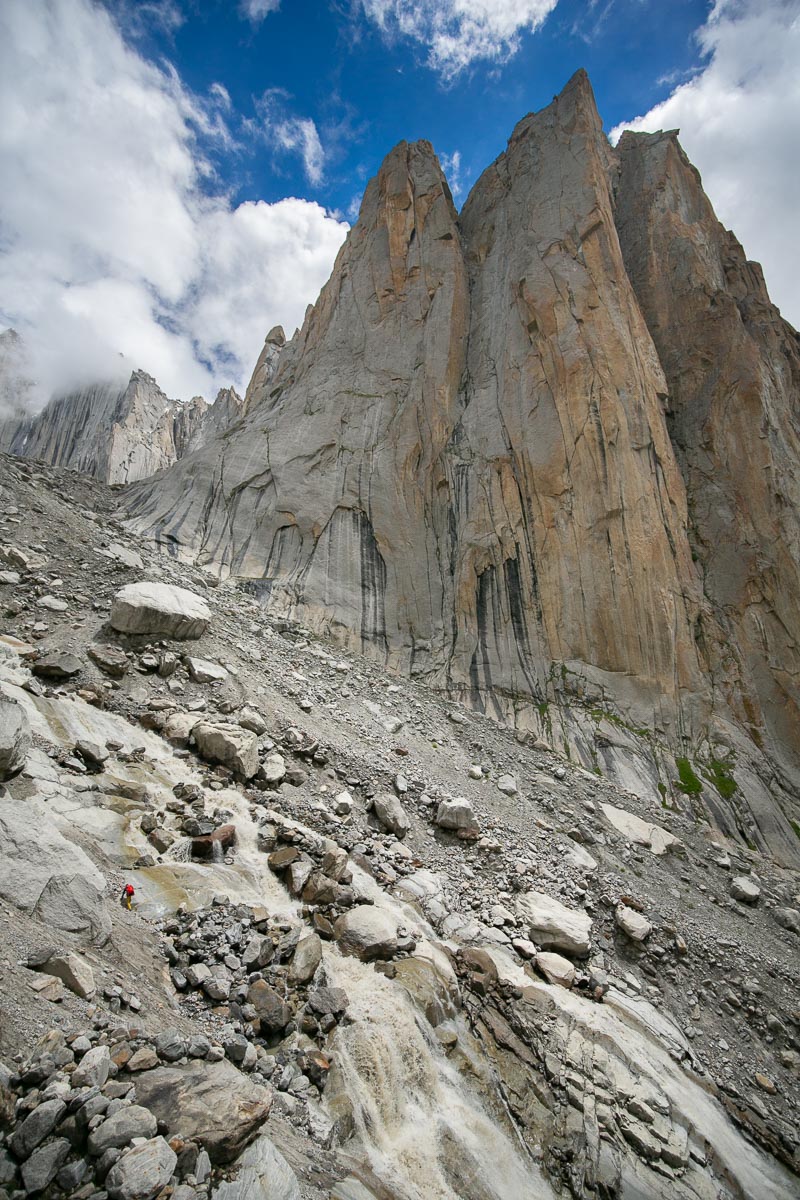
BLOODY MARY
“Bloody Mary” is a route of ascending tendency — the higher you climb, the higher is the quality of climbing. (Editor’s note: It was first ascended by Pavel “Džony” Jonák and Vašek “Šatavis” Šatava in 2004.) The first length presented itself as a very cold shower. An innocent-looking 6b, Anička Šebestíková on the sharp end, what could possibly happen? Answer. We were almost humbled by “Oh, the mighty weed!” The lush vegetation rooted deep in the cracks made it impossible not only to climb the 6b comfortably, but also to place any protection. The drama lasted perhaps over an hour, fingertips on a cold gri-gri, sweaty throughout, but she made it. We reached a belay, even with one fixed bolt. It’s my turn. Difficult 6c, I’m seeing green. I’m equipped with a nut tool and, most importantly, a steel brush, without which we’d be doomed.
The procedure is as follows:
You step on the turf, you grab the clump of turf, you use the brush to cut the dirt in the area where you suspect a crack to place a cam, you fight tooth and nail, the brush comes in, the clump falls, the bristles sparkle, the crack shows, it’s still wet, you insert the cam, you grab the clump of turf, you climb the turf, you live the turf!
At times I was even amused by the absurdity of it (photo), at other times, besides the dirt, curses fell from me and the “overhanging” section was a struggle to climb over. Just everything. I haven’t had so much fun climbing a 6c in years. We climb one more length and agree that we really don’t want to do this again tomorrow and that it would be a hundred times better with ice axes. We leave the ropes hanging and walk happily back to camp.
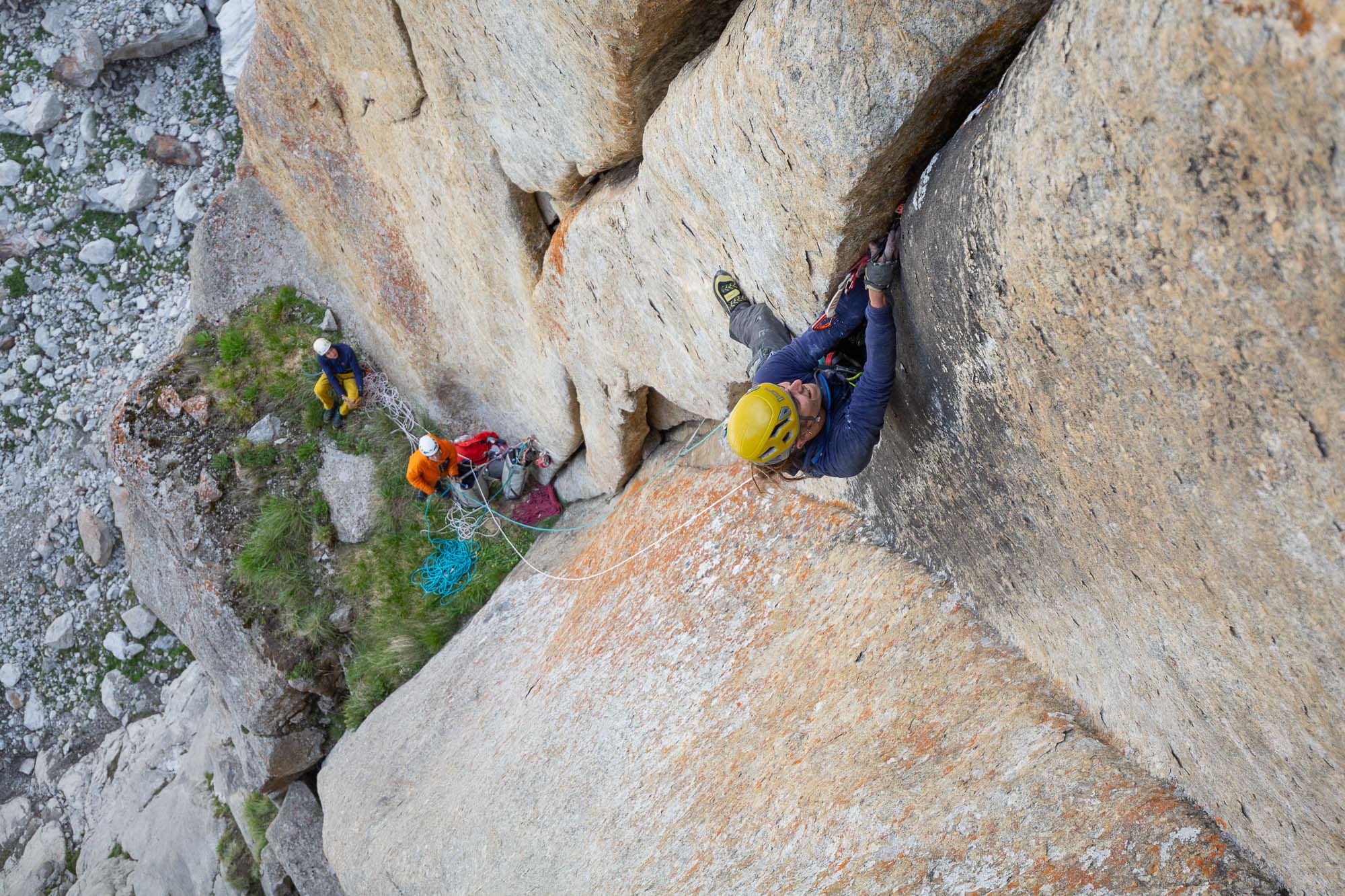
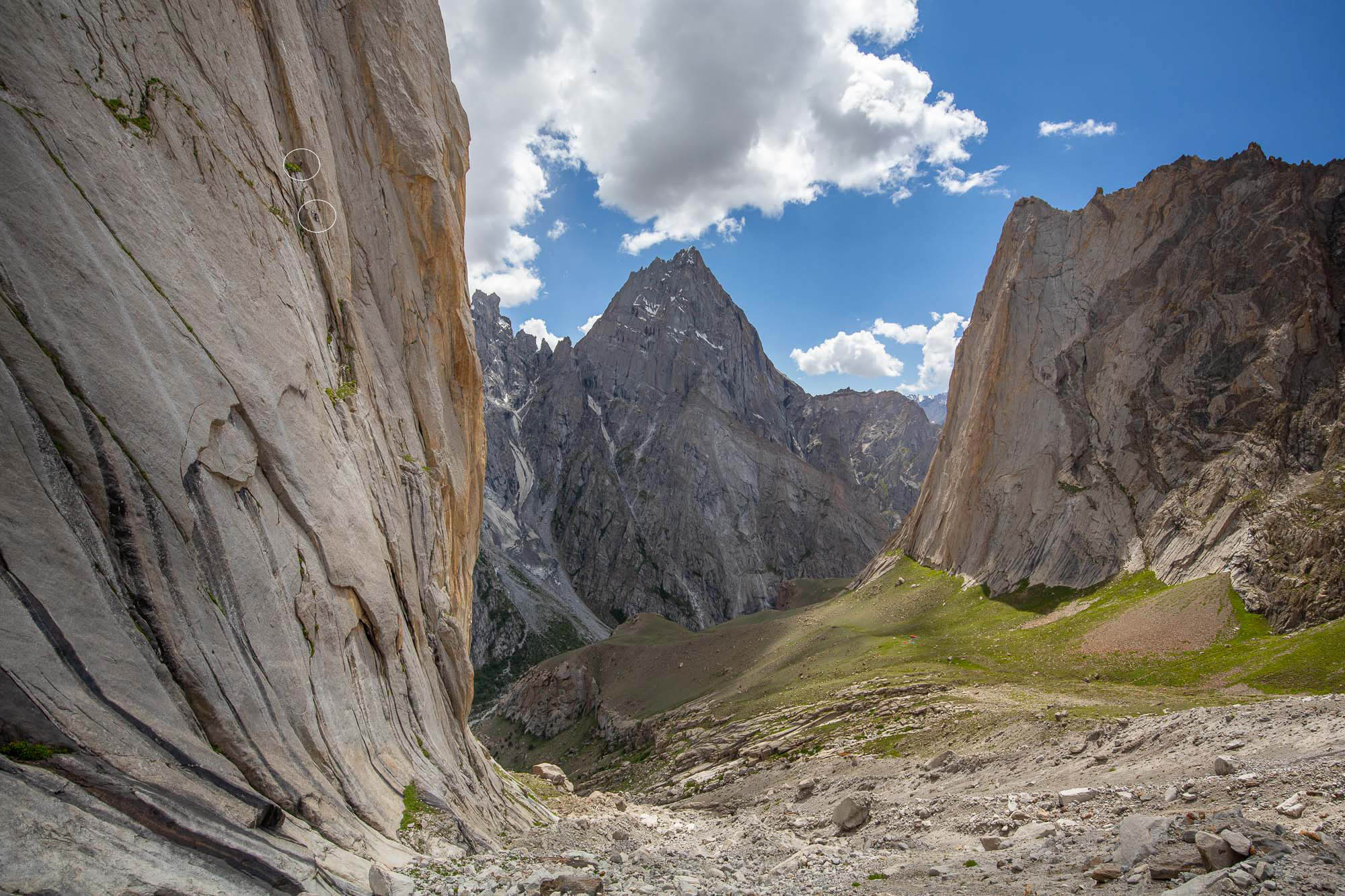
THE PUSH
The next morning we stand under the wall with Standa and Ondra Hašek. Standa is going to take photos of us. The fourth pitch is considered to be the the first hard pitch (7b) and forms a beautiful, slightly overhanging crack, continuing with a much less beautiful wet chimney and ending with a double crack. Unfortunately, Anča then had to lead an overgrown, hard to belay pitch, but after that it was really worth it. Especially when we climbed up to the exposed face which is intersected by a perfect continuous crack more than 100 metres long. And in the middle, right under the crux roof, we slept. It was beautiful, but bivouacking completely in the air in a bare wall with a single crack is no picnic. It took us at least two hours to finally get into our beds and sleep.
Note on inflatable portaledges:
They have pretty obvious advantages (weight, no need for a mattress, they float in a swamp), but also pretty significant disadvantages. In short, they’re great and comfortable to sleep on, better than a hard portaledge, but everything else is pretty stupid to do on them, and don’t try to hang them on the same plane (like a double bed).
PAKISTANI CHAPLIN
For breakfast in bed, an off-width at all angles — do you like it vertical, slabby, or perhaps overhung? I write this as a menu choice, but in reality it was served straight to us and we had to consume it meter by meter. At least you can sit up in bed during belaying, that’s good. First to go is Anička, of course, hopefully getting to the lip of the roof during her onsight go, the cams swaying in surprise at her breasts (instead of her thighs) and Chaplin would have applauded. There’s a welcome spit on the edge, but there’s no hold…
There’s a moment of tension and footwork magic, but nothing, she falls. “Well, this is going to be interesting, all the roof offwidths I’ve climbed have had a hold or something on the edge, but this is a crazy hard boulder.” She tries to figure out the sequence a few more times, but her strength soon runs out and it’s my turn. “Wow, that’s probably harder than ‘Turkey Crack’!” (Editor’s note: a traditional 8a in Cadarese, Italy) declares Anička convincingly.
I know how to climb offwidths (like an average climber), but I haven’t tried a roof offwidth yet and I know that there is no one better than Anička in the Czech Republic. I’m just getting on so she can rest. Already the first part in the vertical terrain is quite tiring; of course I mess up and I’m already swinging. I’m cursing a bit, because I know I can’t do anything here anyway. Chaplin-like movement in the roof works and it’s quite fun. Then I examine the edge carefully to see if there’s a hold, but there isn’t. I don’t worry too much and save my strength for the rest of the wall — it’ll be needed.
What now? Anča says she won’t climb it today, but she can at least try AF style. I’m annoyed, I didn’t come here to AF the wall. That’s the style for Saxony. But we have to accept it — we have a lot of climbing to do. There is still the possibility to go back a little lower and climb it from the left for 7c like the English who can’t or won’t draw topos, but we dismiss that option. It would then be an unfair free climb and this is a clear kingline. AF is also a style — better than A1. So Annie pulls up to the boulder and climbs it first go. Yeah, maybe she could have given it another shot. I follow her up. I hear it was still a decent battle over the lip and she didn’t place much protection there.
THREE CENTIMETERS OF FEAR
After a beautiful double crack comes an overhanging traverse, according to the topo 7b+ AF. That’ll be for me. Suspicious, I measure holds and cracks from the belay, feeling the insidious and uncomfortable climbing in poor rock. It’s all come true. First, I got tremendously pumped downclimbing using the undercuts and bad foot holds… Because of the traverse, I can’t even place much protection because then it still goes up somewhere and I don’t want to risk any rope drag. I shake out and climb into the boulder problem, protected by a bolt. I smear again and hang in the rounded slopers. There’s nothing further and even further is the jug — I have to get there, the stopwatch of my forearms neurotically ticking…
Damn, I have to think of something, I don’t want another attempt and I don’t have the strength for it. So I try to climb even higher, put my feet completely in front of my hands, which I move to closer and rounder holds, I’m almost in a horizontal position. I reach for the jug and just reach it, luckily it really is a jug! I quickly swing my legs over and in a moment I’m standing on it, breathing heavily. Such moves at an altitude of around 5,000 metres are hard. Yes! The climb eases off and we are below the next crux pitch, which, however, we first have to drill out and then bolt the spits (Editor’s note: with the prior agreement of the first ascenders) so that it can be climbed free.
WHERE ARE THE RIVETS?
We knew from the first-ascenders what we were in for, and we thought we were ready. They said they had climbed it thanks to the so-called rivets, which you could see from the photos. A rivet is actually an ordinary bolt hammered into a small hole (about 3 cm deep). You put the wire from a nut on the bolt and stand in it. Simple and safe. We had the nuts and took skyhooks just in case. Just before we left, I called Šatavis about the rivets and he said he wasn’t sure if they climbed it by aiding using the skyhooks between the rivets. He explained that I needed “talon hooks” for this, which have a six millimeter tip at their narrowest. Then you hand drill a centimeter-deep hole and hang the hook in it. “Oh, well, I hope that’s not necessary, but you’d better be prepared.” So at the last minute, we buy two talon hooks.
Now we’re sitting in the belay looking at the clean wall — no rivets anywhere! Only about 15 metres above us a bolt glistens. What now? I put my gear on, put on my shoes and go. Nothing to do but test the skyhooks. Tentatively, I hang in the first hooks where there is still a natural positions for them, but this soon disappears. So I move on to drilling the miniature holes. There is literally one significant drawback to this procedure — namely, the climber leaves no fixed or other protection behind to catch him in the event of a fall. No mistakes allowed.
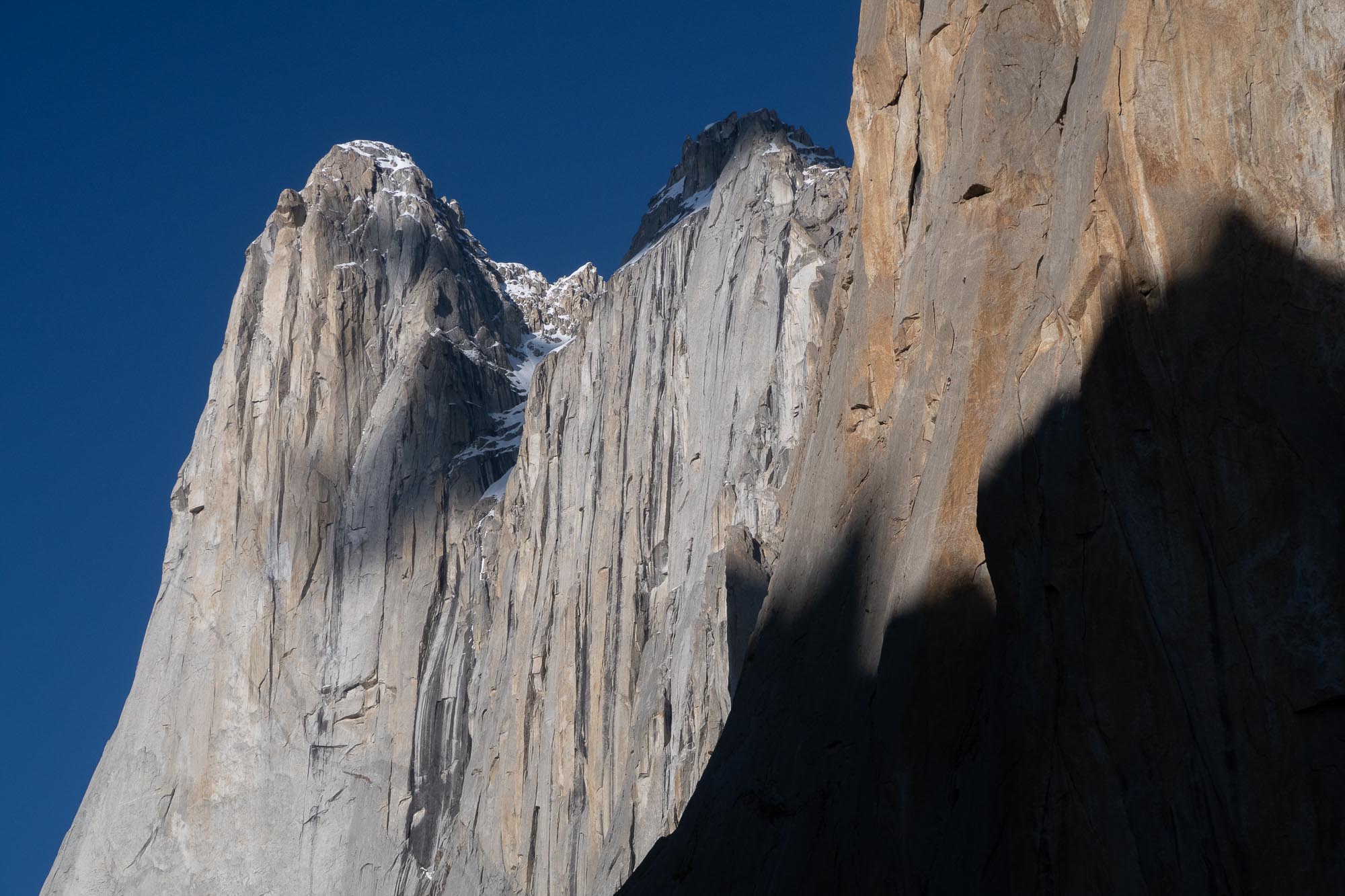
AID MARATHON 42,5 M
It’s going terribly slow, after half an hour I’m less than four metres away from Anča and I’m scared. Next, it looks like I could climb free, which would save a lot of time. I decide to try to drill one of the spits and climb as far away from it as possible. Easily said, harder done. From the two skyhooks, I’m hammering in a spit by hand for the first time in my life. The difficulty is extreme, the speed is snail-like. After half an hour of pounding, it’s there, and I can finally free myself from the skyhooks.
I switch to my climbing shoes. After a few meters I reach a passable sling placement, but further on it looks too hard again and I don’t want to fall into the sling at all. The aforementioned spit is laughing at me six metres diagonally to my left. The only way to reach it is via the hooks. Oh well, never mind, I still have my rivets in reserve, which I can use after a while. I try that, too, one meter at a time, only disaster: I bought hex bolts and they are unfortunately too small for the hex hole! I swear to myself and contemplate my next course of action.
This section purely on the skyhooks is no longer A2, but at least A3! I doubt that the sling would still hold the swing if I fell, in which case I would end up somewhere deep below Anča – if the rope held, that is. Of course, I can give up on it too, but Anča certainly won’t do it for me and I won’t give up in such a disgraceful way. “You don’t have any kids or a wife, so you can take some risks, right?” runs through my head. Just keep your nerve and don’t make a mistake. If I accept it like that, it’s actually going well.
In a few moments, I successfully clip a bolt and I’m safe again. Above me, I finally see the famous rivets. Of course, the guys weren’t doing the same crazy thing I was — they had pitons and normally put them through a thin vein right under the spit. But they forgot about it and we didn’t take too many pitons. Lesson for next time… I’m aiding briskly on the rivets now, but I spent almost four hours on the whole pitch. Psycho. We make our beds and go to sleep — again in the dark, again hanging in the air.
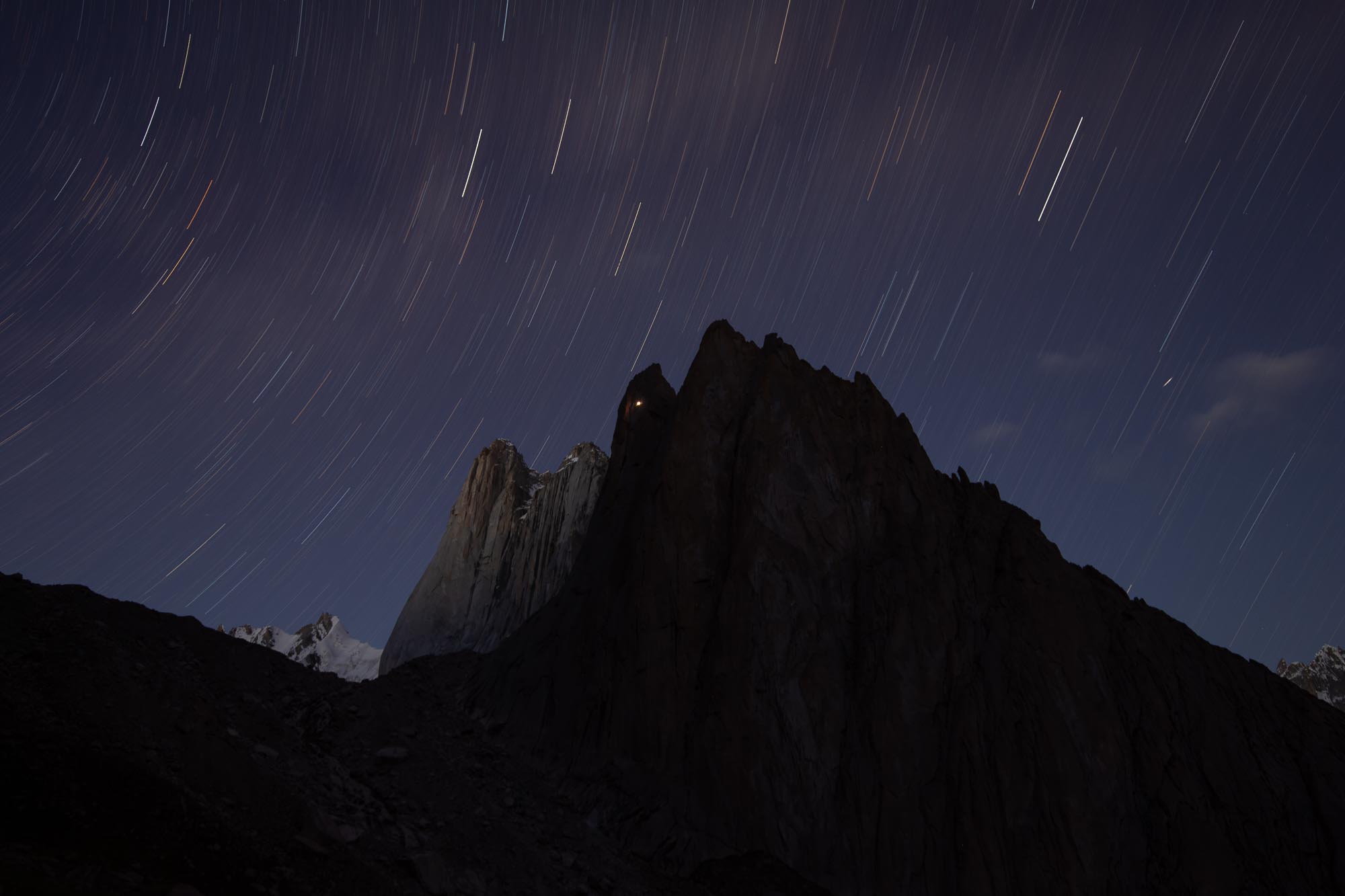
SUMMIT
On my third day on the wall, I wake up in pieces. I don’t want anything. After performing the necessary morning rituals, I go down the fix rope to try to climb the aid pitch free on the top rope. Fortunately it’s a vertical, technical climb in a really good rock, so the initial reluctance quickly fades and I even manage to climb the pitch TR cleanly during my first try. Along the way I slap with my chalked up hand twice, marking places where there might be spits. I drill one of them (only 15 minutes from the rope, note by the author) and Anča the other. With a bit of luck I manage to climb the pitch on my first attempt. We estimated the difficulty at 7b+, maybe even just 7b, but who knows. Joy and a clear path to the top! Only last two pitches and we enjoy the beautiful views of the surrounding snow-capped mountains.
On the descent, Anča still has high hopes of trying the crux roof, which has resisted so far, but alas. She was just a few centimetres away, and much more energy. But it’s not very realistic after four days on the wall. A full party awaits us at the bottom with a welcoming fire and we can rest happily.
Anyway, “Bloody Mary” is a beautiful route for the lovers of extreme offwidths. All our respect for such a line goes to our first-ascenders — Šatavis and Džony.
Location: Denbor Brakk (4800 m n. m.), Nangmah Valley, Pakistan (mapa)
First ascent: Pavel „Džony“ Jonák, Václav „Šatavis“ Šatava younger, July 2004
Length: 450 m of climbing, 14 pitches, 8 rappels (drawn topo, photo topo)
Protection: friends, nuts, spits (fixed bolts on belays)
Difficulty: RP would probably be 7c+/8a (crux roof pitch)
Equipment: Double rack of cams, including o. 4 and no. 5 + microcams + nuts
Style: Team AF, capsule style in four days, 7.–10. August 2023
__________
You have finished reading the article from the final expedition of the cycle Sokolíci 2021–2023, a team of young alpinists of the Czech Mountaineering Federation. Main partner of the project is Mountain Equipment.
__________

